ESA Observing the Earth 
zdroje zpráv:
Clement Albergel on forests and the carbon cycle
15.3.2023 11:08 Video:
00:01:21
Video:
00:01:21
Tropical forests are vital ecosystems in the fight against climate change. Yet vast areas of forest are still degraded or lost through deforestation and environmental changes. Clement Albergel, Climate Applications Scientist at ESA, explains how satellite observations can not only help us to monitor deforestation, but provide valuable information on secondary and degraded forests as well as how much carbon they accumulate.
Reforestation in Rio Capim, Amazon
15.3.2023 10:58 Video:
00:00:08
Video:
00:00:08
A series of USGS Landsat and Copernicus Sentinel-2 images showing secondary forest regrowth near Rio Capim, in the Brazilian Amazon, from 1985 to 2022.
Carbon dioxide monitoring mission in development
14.3.2023 11:00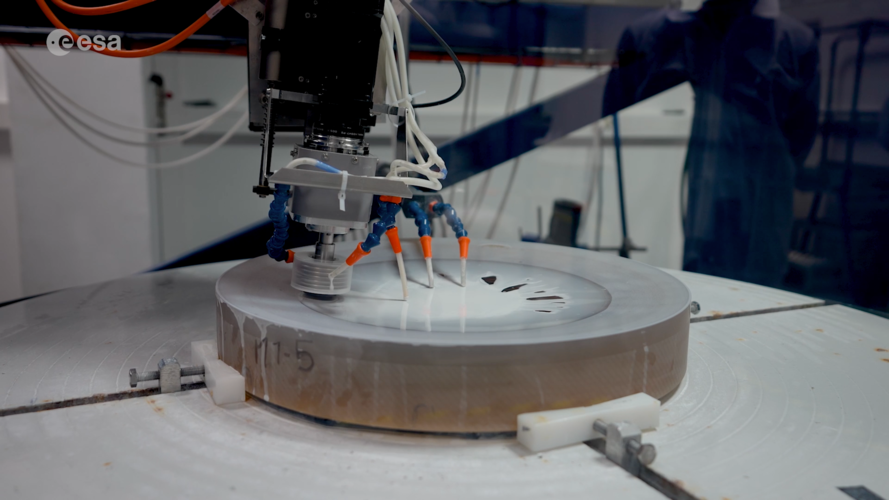 Video:
00:04:58
Video:
00:04:58
The pressure is on to reduce the amount of greenhouse gases we pump into the atmosphere – but the race is also on to support the monitoring that shows if targets are being met. Being developed by ESA on behalf of the EU, the new Copernicus Anthropogenic Carbon Dioxide Monitoring mission, or CO2M for short, is destined to be Europe’s prime mission for monitoring and tracking carbon dioxide emissions from human activity. CO2M is currently planned as a two-satellite mission, each of which will carry a near-infrared and shortwave-infrared spectrometer to measure atmospheric carbon dioxide at high spatial resolution. Engineers at Thales SESO in France explain how the development of some of the mission’s precision measuring and optical components is going.
Earth from Space: Graham Coast, Antarctica
10.3.2023 10:00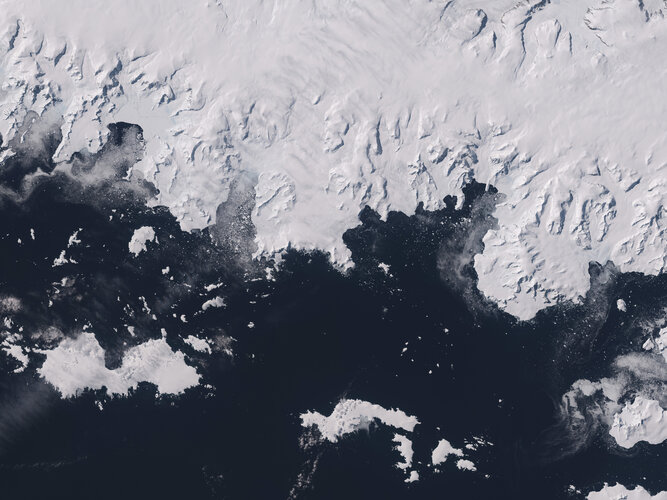 Image:
The icy landscape of Graham Coast, which lies on the west side of the Antarctic Peninsula, is featured in this Copernicus Sentinel-2 image.
Image:
The icy landscape of Graham Coast, which lies on the west side of the Antarctic Peninsula, is featured in this Copernicus Sentinel-2 image.
HydroGNSS twice as good
6.3.2023 14:57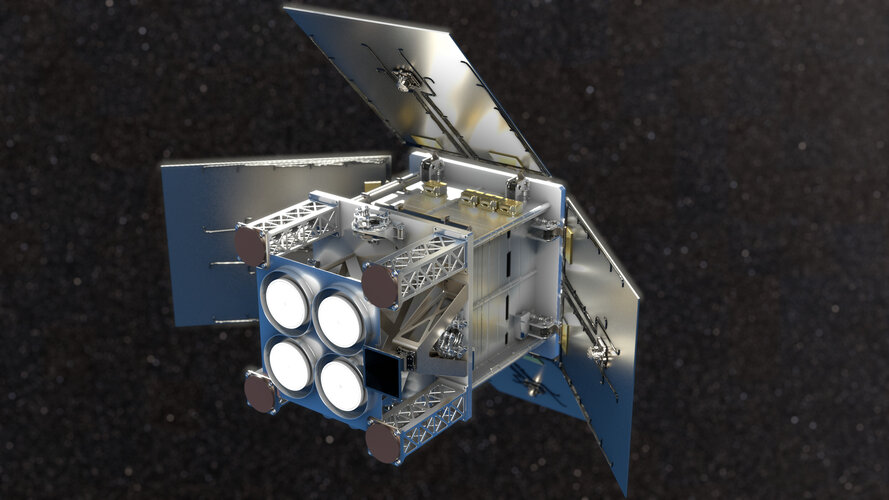
ESA’s HydroGNSS mission will now comprise two identical satellites to halve the time it takes to revisit the same place on Earth’s surface and re-measure various climate variables such soil moisture. Having two satellites in orbit will significantly improve the science that this exciting new Scout mission will yield.
Earth from Space: Poyang Lake, China
3.3.2023 10:00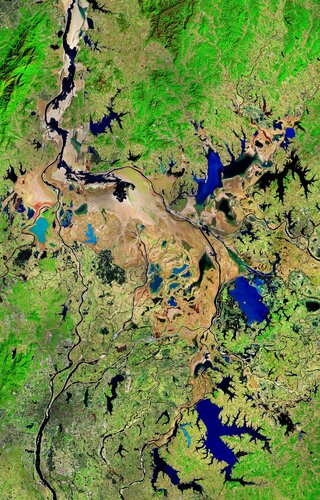 Image:
This Copernicus Sentinel-2 image shows Poyang Lake in China’s Jiangxi Province during winter.
Image:
This Copernicus Sentinel-2 image shows Poyang Lake in China’s Jiangxi Province during winter.
Antarctic Peninsula glaciers on the run
27.2.2023 17:00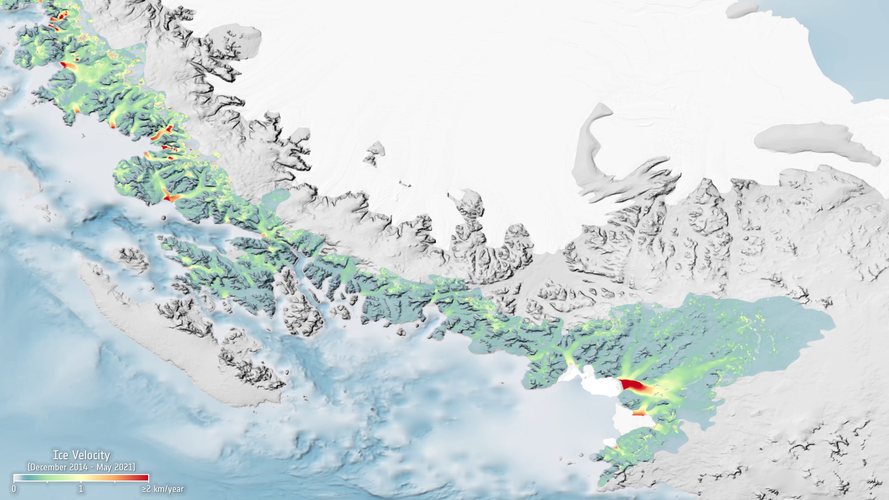
Like many places, the Antarctic Peninsula is falling victim to rising temperatures. However, when scientists used radar images from the Copernicus Sentinel-1 mission acquired between 2014 and 2021, they were taken aback to discover just how the fast 105 glaciers on the west coast are flowing in the summer months.
Earth from Space: The Triple Frontier
24.2.2023 10:00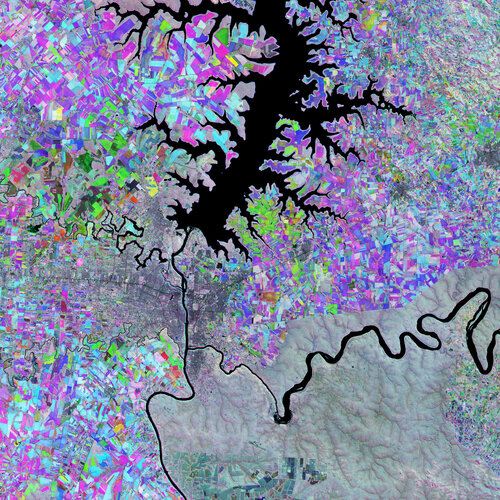 Image:
The Triple Frontier, a region where Paraguay, Brazil and Argentina meet, is featured in this false-colour image, captured by the Copernicus Sentinel-2 mission.
Image:
The Triple Frontier, a region where Paraguay, Brazil and Argentina meet, is featured in this false-colour image, captured by the Copernicus Sentinel-2 mission.
ESA’s forest satellite robust for launch
23.2.2023 14:00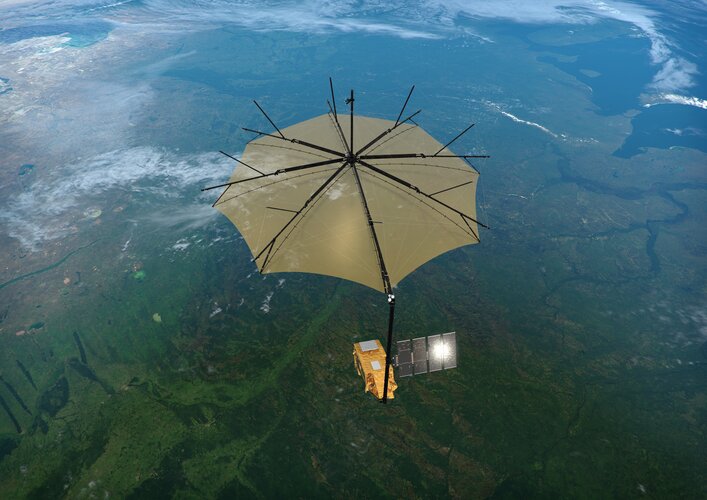
Over the last few months, ESA’s Earth Explorer Biomass satellite has been going through a punishing series of tests to make sure that it will survive the unavoidable blasts of noise and shuddering during liftoff. Engineers have now also tested that it will unfold its solar wing in the correct sequence. Coming through all of this with flying colours, Biomass is a few steps closer to its mission in orbit: to deliver completely new information on our precious forests and the carbon they store.
The ozone layer: a whole new world
23.2.2023 13:00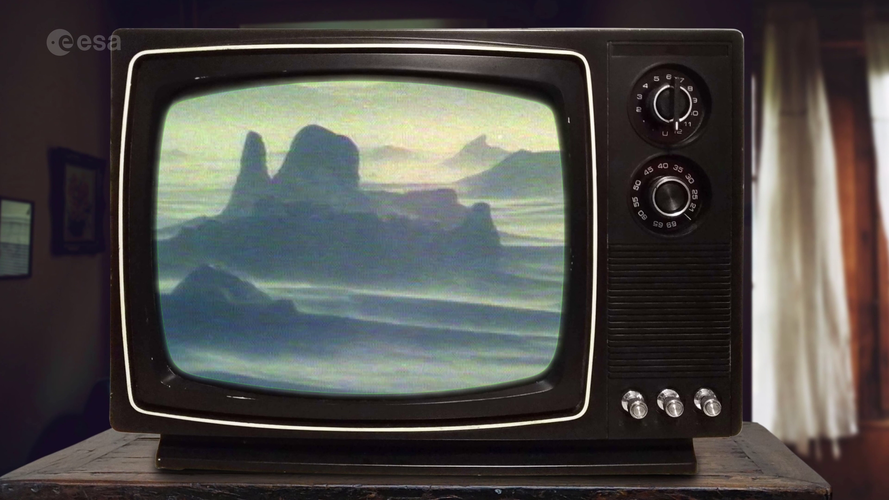 Video:
00:08:47
Video:
00:08:47
In the 1980s, scientists discovered a gaping hole in Earth's ozone layer, caused by humanmade chemicals. But thanks to the historical Montreal Protocol, the world came together to take bold action to save our planet. Decades later, we can see the steady recovery of the ozone hole. How did we do it? And what does space have to do with it? Join us as we explore the journey of the ozone hole, from its alarming discovery to the incredible strides made to fix it, and how satellites are helping us track its recovery.
The ozone layer: a hole new world
23.2.2023 13:00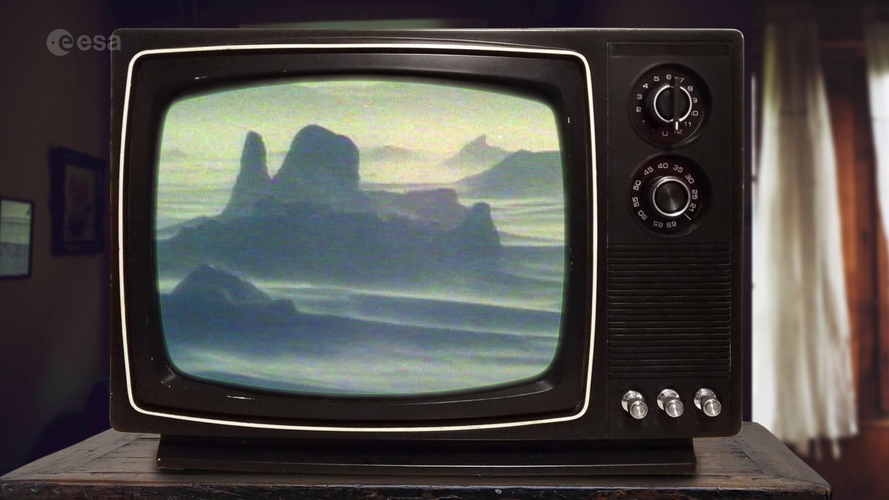 Video:
00:08:47
Video:
00:08:47
In the 1980s, scientists discovered a gaping hole in Earth's ozone layer, caused by humanmade chemicals. But thanks to the historical Montreal Protocol, the world came together to take bold action to save our planet. Decades later, we can see the steady recovery of the ozone hole. How did we do it? And what does space have to do with it? Join us as we explore the journey of the ozone hole, from its alarming discovery to the incredible strides made to fix it, and how satellites are helping us track its recovery.
Copernicus Sentinel-2 helps explorers unearth rare 7.6 kg meteorite in Antarctica
21.2.2023 11:03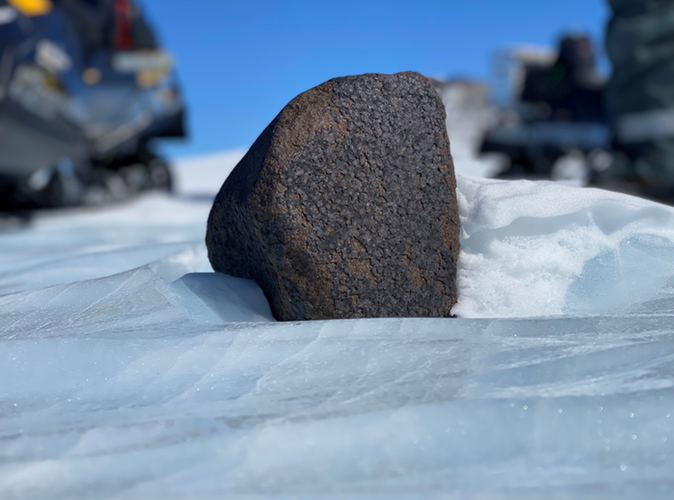
Copernicus Sentinel-2 helps explorers unearth rare meteorite
Call opens for ESA’s twelfth Earth Explorer
20.2.2023 12:00
Understanding Earth’s delicate natural balance and how it is being altered by human activity is not only key to advancing science but also fundamental to acting on environmental issues, the climate crisis, and preparing for their societal impact. With their hallmark of demonstrating novel space technologies and returning scientific excellence, ESA’s family of Earth observing Earth Explorer research satellite missions are world-renowned – and now it’s time for scientists to pitch their new ideas for the twelfth mission in this outstanding series.
Earth from Space: Liverpool Land, Greenland
17.2.2023 10:00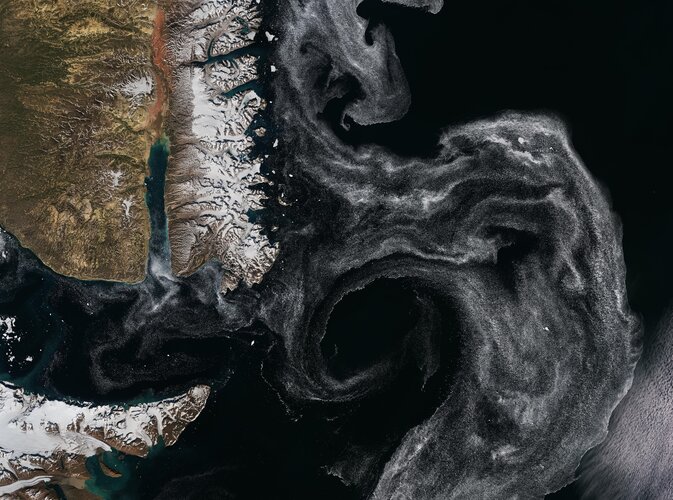 Image:
The Liverpool Land peninsula, on the east coast of Greenland, is featured in this Copernicus Sentinel-2 image.
Image:
The Liverpool Land peninsula, on the east coast of Greenland, is featured in this Copernicus Sentinel-2 image.
Satellite data now used for road infrastructure safety in Italy
16.2.2023 11:00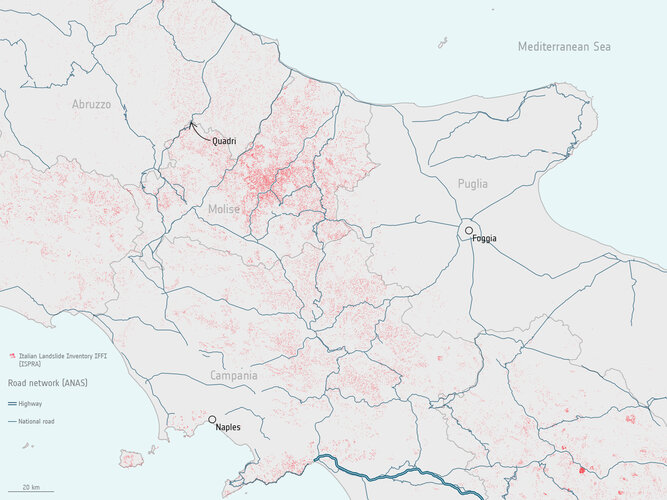
A new ground motion service utilising Copernicus satellite data is being used by the Italian road agency to detect and monitor unstable ground – helping improve nationwide road infrastructure safety.
Satellite data used for road infrastructure safety in Italy
16.2.2023 11:00
A new ground motion service utilising Copernicus satellite data is being used by the Italian road agency to detect and monitor unstable ground – helping improve nationwide road infrastructure safety.
Boosting market traction for agri-monitoring service
15.2.2023 14:00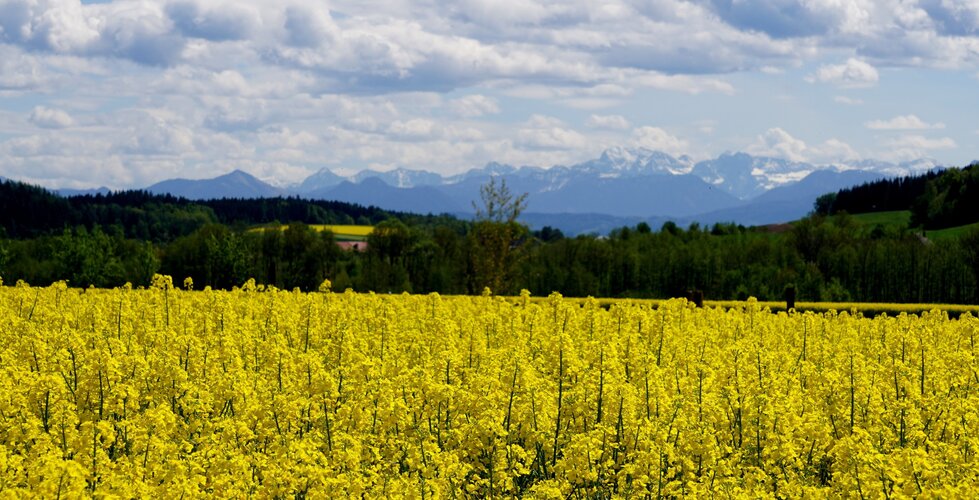
Support from ESA’s Earth observation InCubed commercialisation programme has enabled two companies, GeoVille and EOX, to secure a major contract to provide an Austrian Area Monitoring Service. The consortium’s EO-WIDGET software provides the farming sector with critical satellite-derived information and is a key tool in compliance monitoring for the European Common Agricultural Policy.
Satellites support impact assessment after Türkiye–Syria earthquakes
13.2.2023 12:45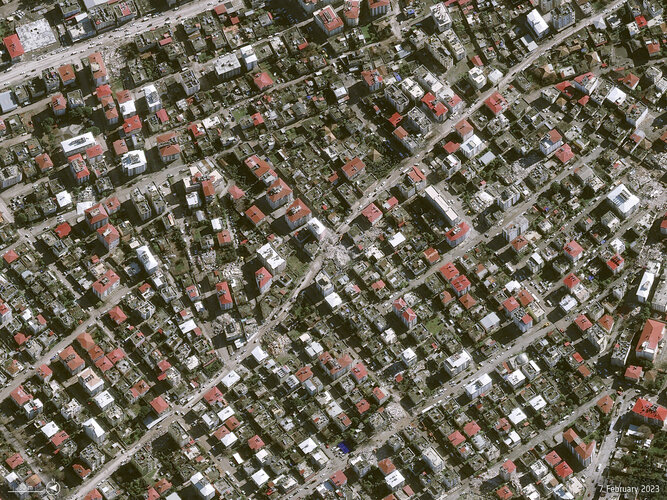
Türkiye and Syria are reeling from one of the worst earthquakes to strike the region in almost a century. Tens of thousands of people have been killed with many more injured in this tragedy.
Satellite data are being used to help emergency aid organisations, while scientists have begun to analyse ground movement – aiding risk assessments that authorities will use as they plan recovery and reconstruction, as well as long-term research to better model such events.
Earth from Space: Swedish landscape
10.2.2023 10:00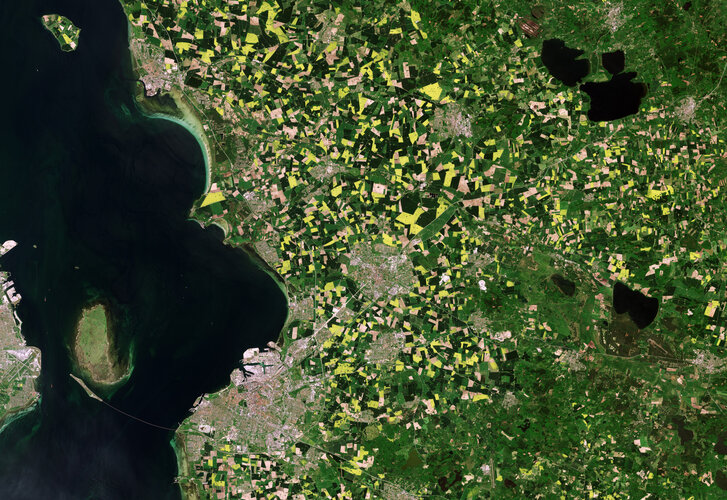 Image:
Agricultural fields that surround the cities of Lund and Malmö in Sweden are pictured in this image, captured by the Copernicus Sentinel-2 mission.
Image:
Agricultural fields that surround the cities of Lund and Malmö in Sweden are pictured in this image, captured by the Copernicus Sentinel-2 mission.
Sentinel-4 set to join next weather satellite
9.2.2023 9:53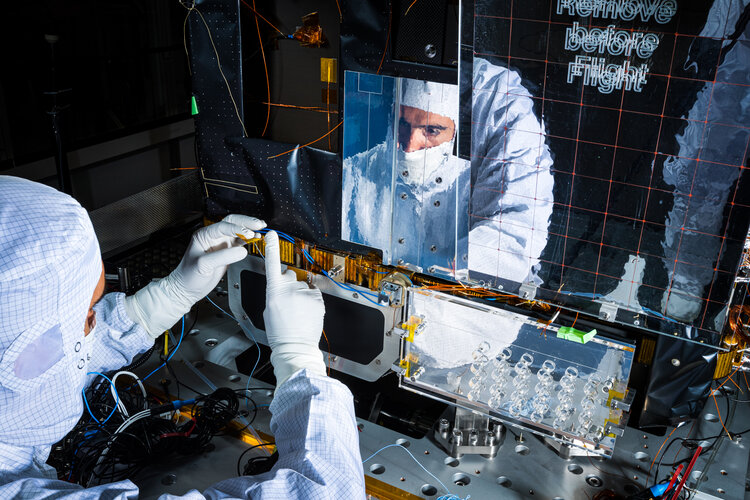
Copernicus Sentinel-4, which is set to play a key role in monitoring air quality over Europe, is ready to be fitted to its host, the first Meteosat Third Generation Sounder weather satellite.
Copernicus Sentinel-4 is a state-of-the-art ultraviolet, visible, near-infrared spectrometer instrument that has been developed to deliver hourly high-resolution measurements of trace gases such as nitrogen dioxide, ozone, sulphur dioxide and formaldehyde, as well as aerosols.
Europe’s next radar satellite tip-top for flight
7.2.2023 15:59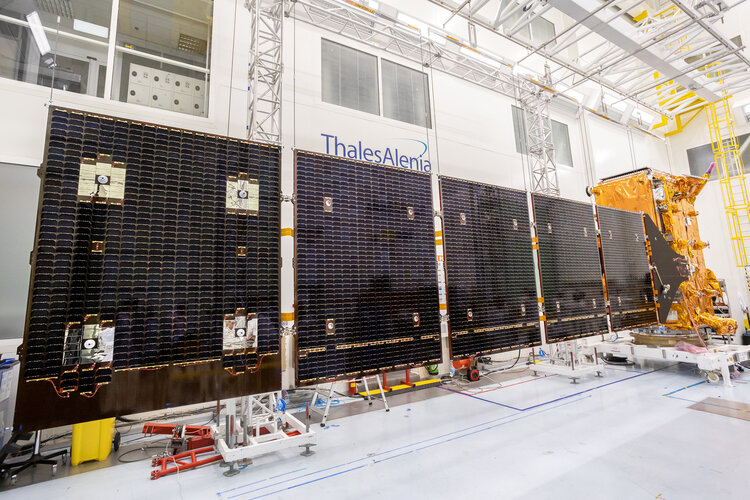
Following its arrival at Thales Alenia Space’s cleanroom facilities in the south of France last October, Europe’s next radar satellite, Copernicus Sentinel-1C, has been put through its paces in a series of tests and demonstrated that it is in tip-top condition for flight. Engineers have also carried out the all-important and precise check to ensure that the satellite fits on the adapter that connects it to the rocket that will take it into orbit.
Chile battles raging wildfires
7.2.2023 14:26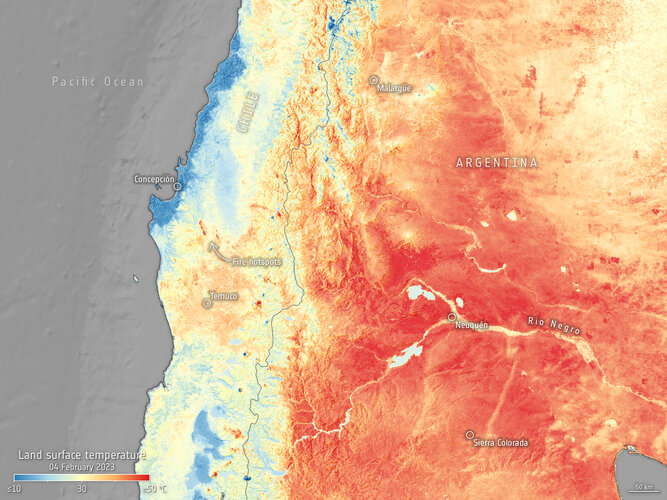 Image:
Deadly wildfires continue to rage in south-central Chile destroying hundreds of thousands of hectares of land across the country. Satellite images captured by the Copernicus Sentinel-3 mission on 4 February show the ongoing fires and heatwave in South America.
Image:
Deadly wildfires continue to rage in south-central Chile destroying hundreds of thousands of hectares of land across the country. Satellite images captured by the Copernicus Sentinel-3 mission on 4 February show the ongoing fires and heatwave in South America.
Earth from Space: Kolkata, India
3.2.2023 10:00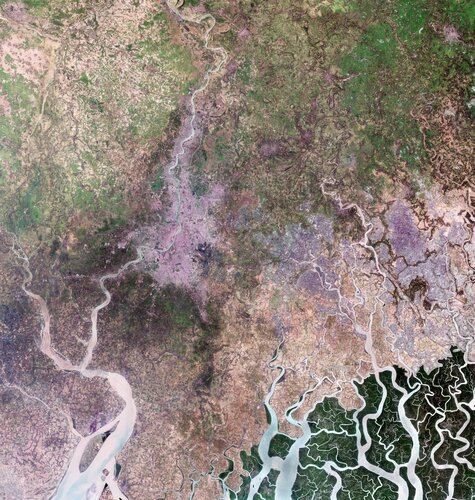 Image:
Kolkata, formerly Calcutta, is featured in this image, captured by the Copernicus Sentinel-2 mission.
Image:
Kolkata, formerly Calcutta, is featured in this image, captured by the Copernicus Sentinel-2 mission.
Iceberg larger than London breaks off Brunt
27.1.2023 15:00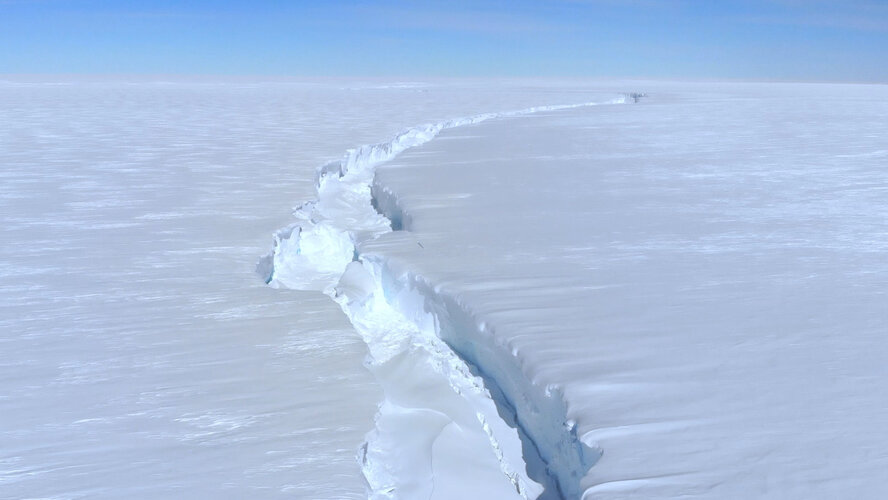 Video:
00:04:25
Video:
00:04:25
An iceberg around the size of Greater London broke off Antarctica’s Brunt Ice Shelf due to a natural process called ‘calving’. The iceberg, measuring 1550 sq km, detached from the 150 m-thick ice shelf a decade after scientists first spotted massive cracks in the shelf.
For more information on the newly-birthed A81 iceberg, click here.
Radar images capture new Antarctic mega-iceberg
26.1.2023 16:27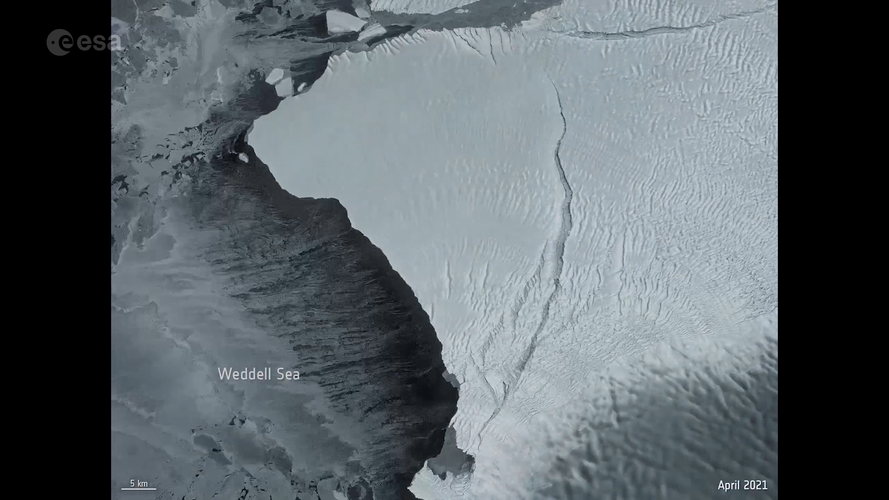 Video:
00:00:23
Video:
00:00:23
Using radar images from the Copernicus Sentinel-1 mission, the animation shows the A81 iceberg breaking away from the Brunt Ice Shelf on 25 January 2023. The new berg is estimated to be around 1550 sq km, which is around the size of Greater London, and is approximately 150 m thick. It calved when the crack known as Chasm-1 split northwards severing the west part of the ice shelf.
The white square indicated the final breakpoint near the McDonald Ice Rumples.
Routine monitoring from satellites offers unparalleled views of events happening in remote regions. The Copernicus Sentinel-1 mission carries radar, which can return images regardless of day or night and this allows us year-round viewing, which is especially important through the long, dark, austral winter months.
Read the full story: Giant iceberg breaks away from Antarctic ice shelf
Giant iceberg breaks away from Antarctic ice shelf
25.1.2023 15:45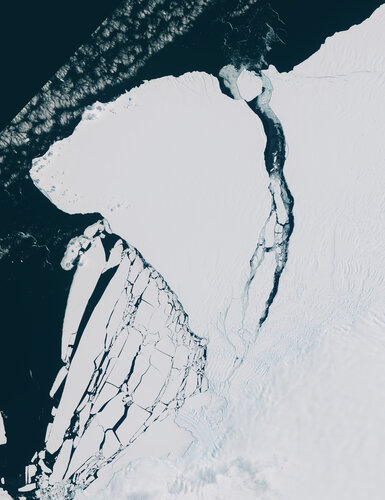
Satellite imagery confirms an enormous iceberg, around five times the size of Malta, has finally calved from Antarctica’s Brunt Ice Shelf. The new berg, estimated to be around 1550 sq km and around 150 m thick, calved when the crack known as Chasm-1 fully extended northwards severing the west part of the ice shelf.
This crack was first revealed to be extending in early 2012 after having been dormant for some decades. After several years of desperately clinging on, image data from the Copernicus Sentinel missions visually confirm the calving event.
ESA and the European Commission uniting on Earth observation for the Philippines
24.1.2023 14:00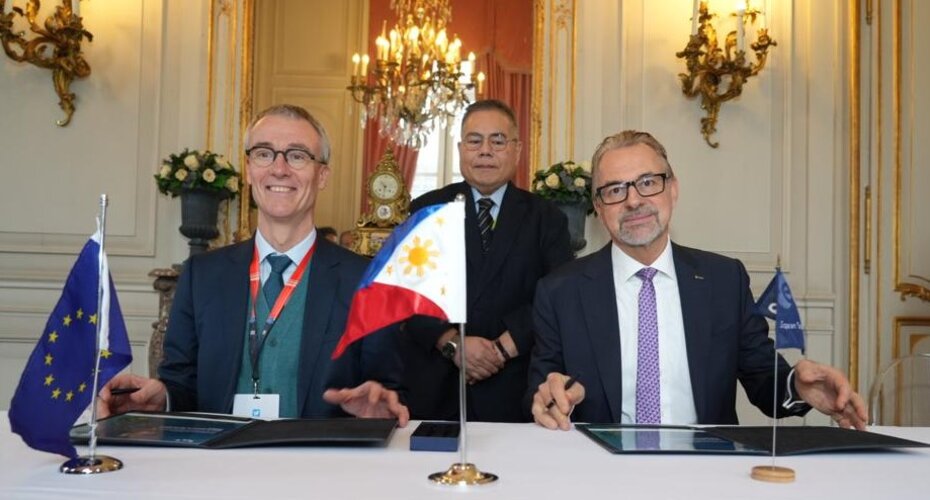
ESA and the European Commission have signed a contribution agreement to build a Copernicus mirror site in the Philippines – the first of its kind in southeast Asia. The new CopPhil initiative will enhance the response capability and resilience of the Philippines to natural and human made disasters through the strategic use of space data. This will help reduce vulnerability of the nation to climate hazards, support climate adaption, food security and environmental protection.
Future-proofing ice measurements from space
19.1.2023 15:06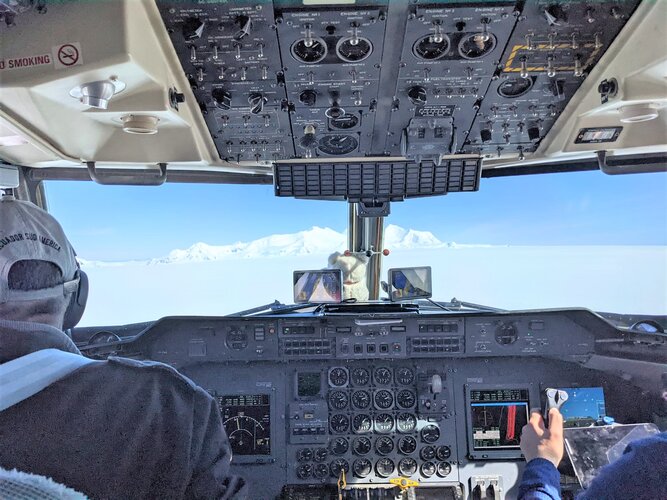
With diminishing ice one of the biggest casualties of our warming world, it’s imperative that accurate measurements continue to be made for scientific research and climate policy, as well as for practical applications such as ship routing. To ensure that ESA and NASA are getting the best out of their ice-measuring satellites and to help prepare for Europe’s new CRISTAL satellite, the two space agencies along with the British Antarctic Survey and a team of scientists teamed up recently to carry out an ambitious campaign in Antarctica.
Future-proofing ice measurements from space
19.1.2023 15:06
With diminishing ice one of the biggest casualties of our warming world, it’s imperative that accurate measurements continue to be made for scientific research and climate policy, as well as for practical applications such as ship routing.
To ensure that ESA and NASA are getting the best out of their ice-measuring satellites and to help prepare for Europe’s new CRISTAL satellite, the two space agencies along with the British Antarctic Survey and a team of scientists teamed up recently to carry out an ambitious campaign in Antarctica.
Looking back at the eruption that shook the world
16.1.2023 11:05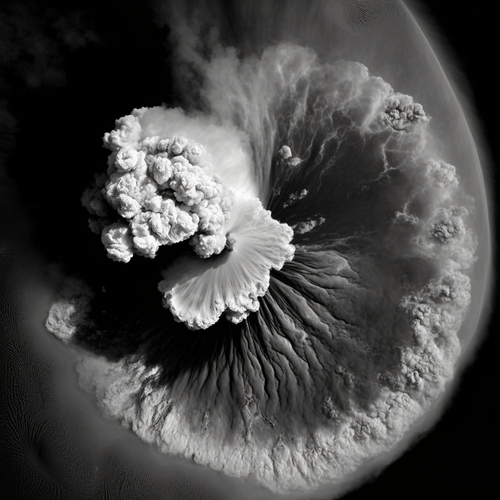
One year ago, the Hunga Tonga-Hunga Ha’apai volcano erupted, causing widespread destruction to the Pacific Island Nation of Tonga, spewing volcanic material up to 58 km into the atmosphere. It brought a nearly 15 m tsunami that crashed ashore, destroying villages, and creating a sonic boom that rippled around the world – twice.
Satellites orbiting Earth scrambled to capture images and data of the aftermath of the disaster. Almost a year later, you can now listen to a sonification of the largest eruption of the 21st Century, created using wind data from ESA’s Aeolus mission.
Snowless ski slopes from space
12.1.2023 12:00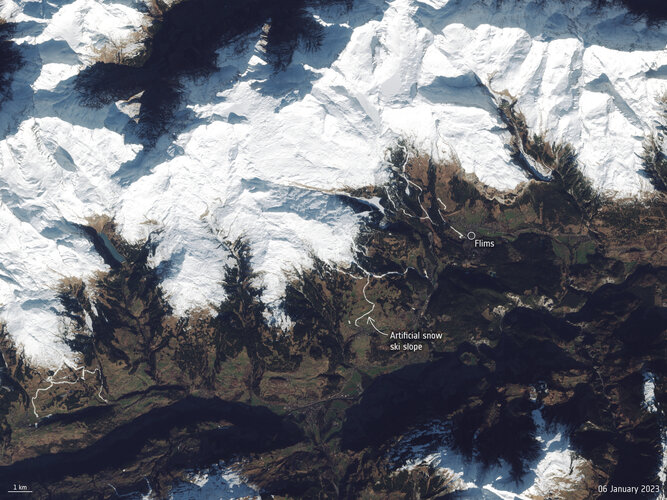 Image:
Europe has kicked off the new year with an intense winter heatwave. The warm temperatures and lack of snowfall in the Alps has left several ski resorts with little or no snow. The difference in snow cover is visible in these Copernicus Sentinel-2 images captured in January 2022 compared to January 2023.
Image:
Europe has kicked off the new year with an intense winter heatwave. The warm temperatures and lack of snowfall in the Alps has left several ski resorts with little or no snow. The difference in snow cover is visible in these Copernicus Sentinel-2 images captured in January 2022 compared to January 2023.
Sentinel-1 and AI uncover glacier crevasses
9.1.2023 15:32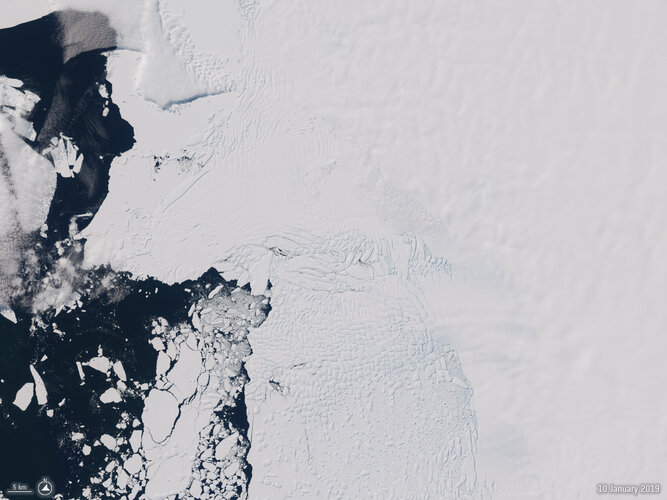
Scientists have developed a new Artificial Intelligence, or AI, technique using radar images from Europe’s Copernicus Sentinel-1 satellite mission, to reveal how the Thwaites Glacier Ice Tongue in West Antarctica is being damaged by squeezing and stretching as it flows from the middle of the continent to the coast. Being able to track fractures and crevasses in the ice beneath the overlying snow is key to better predicting the fate of floating ice tongues under climate change.
Snowy Alps
21.12.2022 11:55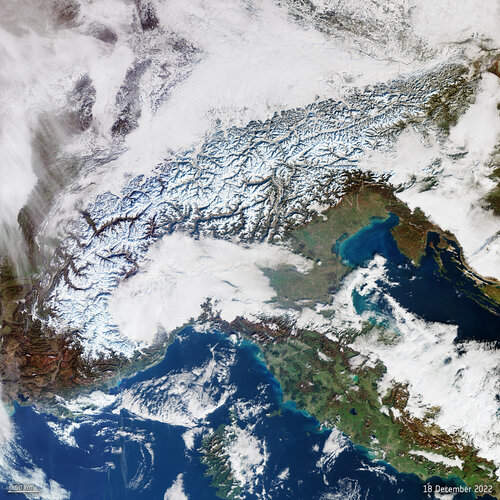 Image:
This Copernicus Sentinel-3 image shows the wide-coverage of snowfall in the Alps, which hopefully bodes well for the coming year.
Image:
This Copernicus Sentinel-3 image shows the wide-coverage of snowfall in the Alps, which hopefully bodes well for the coming year.
Snowy Lapland and the white balloon
16.12.2022 14:12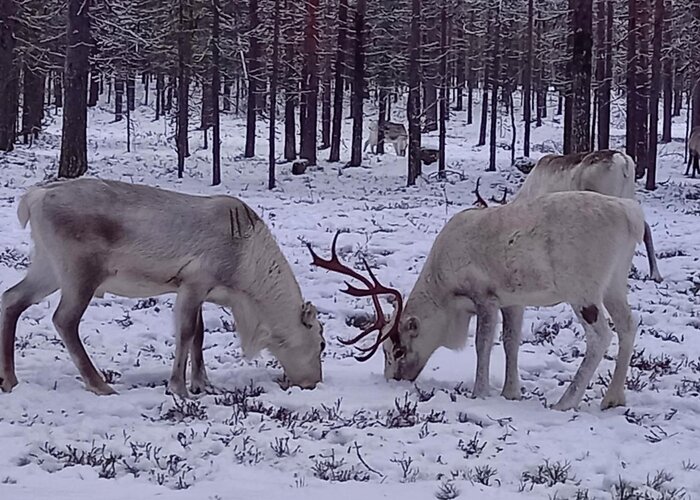
At this time of the year, the mention of Lapland conjures up visions of Santa getting his gift-laden sleigh and nine reindeer ready to take to the skies for the most important deliveries of all. However, the skies of Lapland have witnessed something rather different recently – a big white balloon, which may not provide the immediate gratification of a much-wanted Christmas present, but nonetheless plays a role in helping to safeguard our children’s future.
Earth from Space: Dublin, Ireland
16.12.2022 10:00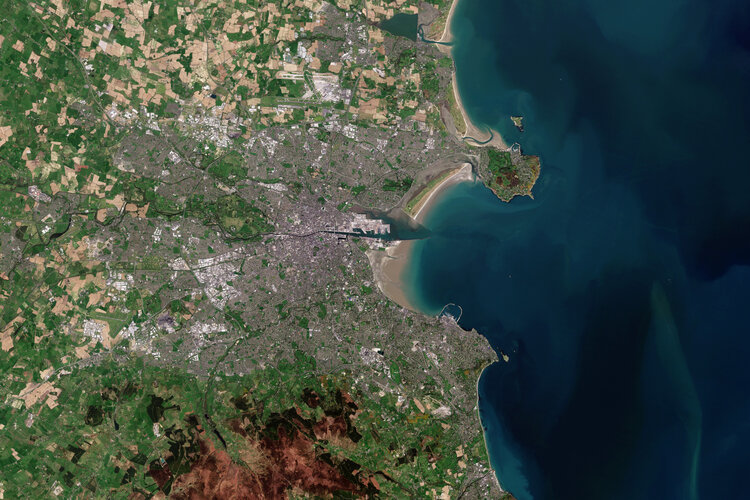
Dublin, the capital and largest city of Ireland, is featured in this image captured by Copernicus Sentinel-2.
Christmas comes early for Aeolus
15.12.2022 15:25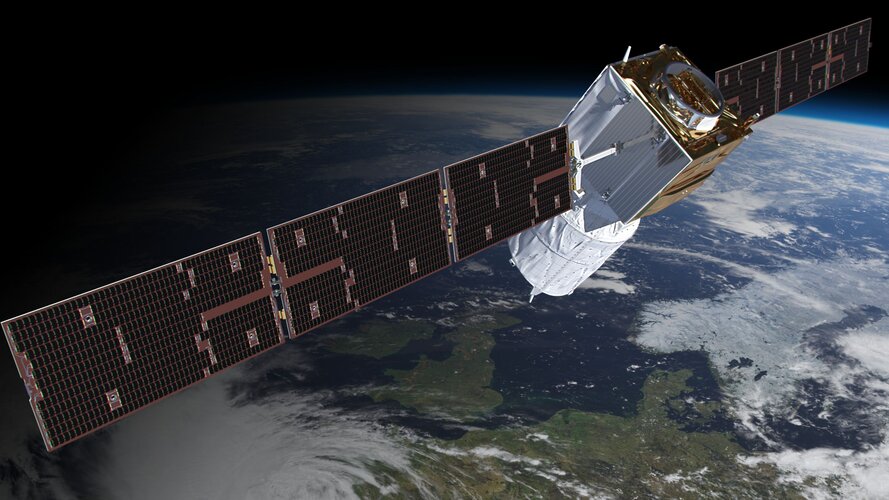
ESA’s wind mission continues to shine as engineers have worked their Christmas magic. With a switch back to its original laser, Aeolus is now shining more than twice as brightly with its best ever performance – just in time for the holidays.
A new era of weather forecasting begins
14.12.2022 0:05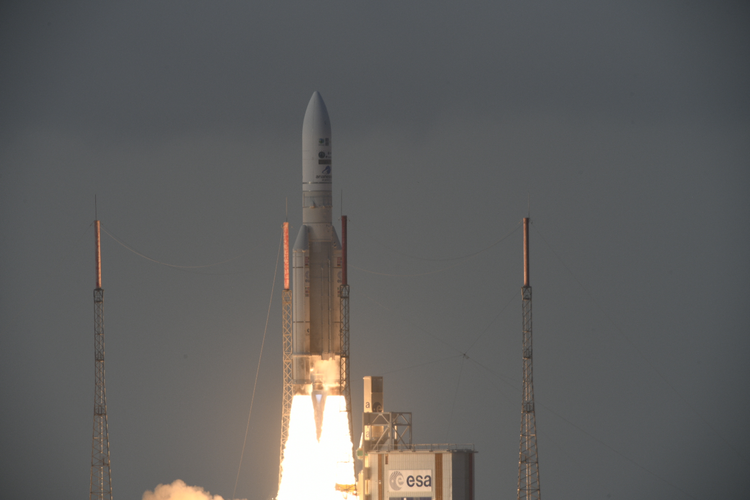
The Meteosat Third Generation Imager satellite, set to revolutionise short-term weather forecasting in Europe, lifted off on an Ariane 5 rocket at 21:30 CET (17:30 local time in Kourou) on 13 December from Europe’s Spaceport in French Guiana.
The satellite separated from the rocket 34 minutes later and then Malindi ground station in Kenya received the signal from MTG-I1, indicating the satellite is in good health.
A new era of weather forecasting begins
14.12.2022 0:05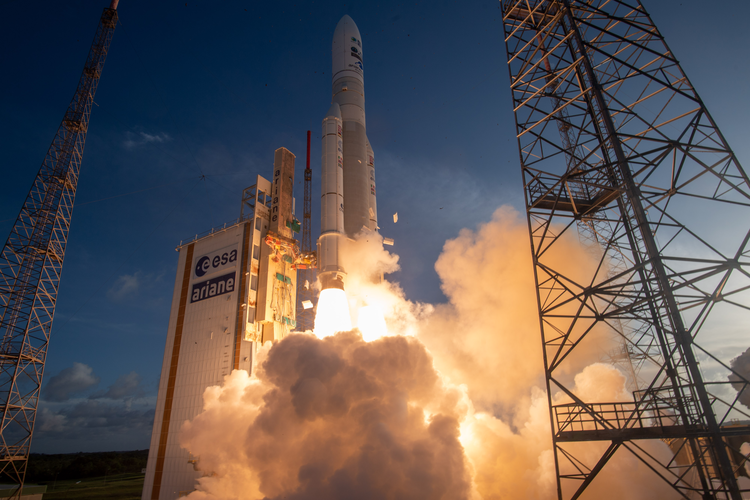
The Meteosat Third Generation Imager satellite, set to revolutionise short-term weather forecasting in Europe, lifted off on an Ariane 5 rocket at 21:30 CET (17:30 local time in Kourou) on 13 December from Europe’s Spaceport in French Guiana.
The satellite separated from the rocket 34 minutes later and then Malindi ground station in Kenya received the signal from MTG-I1, indicating the satellite is in good health.
MTG-I1 launch coverage
13.12.2022 23:00 Video:
03:13:00
Video:
03:13:00
Watch the replay the MTG-I1 launch coverage. The video includes streaming of the event at ESA’s ESTEC establishment in the Netherlands and footage of liftoff from Europe’s Spaceport in French Guiana.
The first Meteosat Third Generation Imager (MTG-I1) satellite lifted off on an Ariane 5 rocket from Europe’s Spaceport in French Guiana on 13 December at 21:30 CET.
From geostationary orbit, 36,000 km above the equator, this all-new weather satellite will provide state-of-the art observations of Earth’s atmosphere and realtime monitoring of lightning events, taking weather forecasting to the next level. The satellite carries two completely new instruments: Europe’s first Lightning Imager and a Flexible Combined Imager.
MTG-I1 is the first of six satellites that form the full MTG system, which will provide critical data for weather forecasting over the next 20 years. In full operations, the mission will comprise two MTG-I satellites and one MTG Sounding (MTG-S) satellites working in tandem.
The MTG mission is a cooperation between Eumetsat and ESA. ESA is responsible developing and procuring the six MTG satellites. Eumetsat defines the system requirements, develops the ground systems, procures the launch services, operates the satellites, and makes the data available to users.
MTG-I1 launch coverage
13.12.2022 23:00 Video:
02:43:00
Video:
02:43:00
Watch the replay the MTG-I1 launch coverage. The video includes streaming of the event at ESA’s ESTEC establishment in the Netherlands and footage of liftoff from Europe’s Spaceport in French Guiana.
The first Meteosat Third Generation Imager (MTG-I1) satellite lifted off on an Ariane 5 rocket from Europe’s Spaceport in French Guiana on 13 December at 21:30 CET.
From geostationary orbit, 36,000 km above the equator, this all-new weather satellite will provide state-of-the art observations of Earth’s atmosphere and realtime monitoring of lightning events, taking weather forecasting to the next level. The satellite carries two completely new instruments: Europe’s first Lightning Imager and a Flexible Combined Imager.
MTG-I1 is the first of six satellites that form the full MTG system, which will provide critical data for weather forecasting over the next 20 years. In full operations, the mission will comprise two MTG-I satellites and one MTG Sounding (MTG-S) satellites working in tandem.
The MTG mission is a cooperation between Eumetsat and ESA. ESA is responsible developing and procuring the six MTG satellites. Eumetsat defines the system requirements, develops the ground systems, procures the launch services, operates the satellites, and makes the data available to users.
MTG-I1 launch coverage
13.12.2022 23:00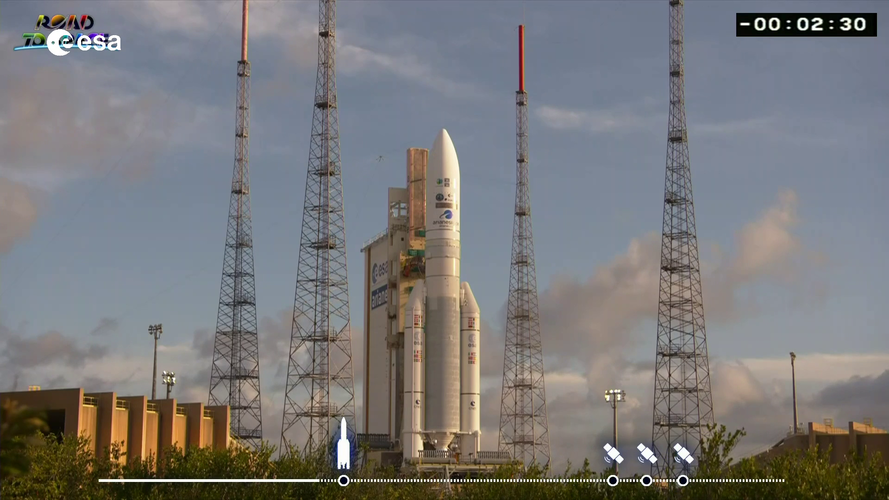 Video:
00:03:13
Video:
00:03:13
Watch the replay the MTG-I1 launch coverage. The video includes streaming of the event at ESA’s ESTEC establishment in the Netherlands and footage of liftoff from Europe’s Spaceport in French Guiana.
The first Meteosat Third Generation Imager (MTG-I1) satellite lifted off on an Ariane 5 rocket from Europe’s Spaceport in French Guiana on 13 December at 21:30 CET.
From geostationary orbit, 36,000 km above the equator, this all-new weather satellite will provide state-of-the art observations of Earth’s atmosphere and realtime monitoring of lightning events, taking weather forecasting to the next level. The satellite carries two completely new instruments: Europe’s first Lightning Imager and a Flexible Combined Imager.
MTG-I1 is the first of six satellites that form the full MTG system, which will provide critical data for weather forecasting over the next 20 years. In full operations, the mission will comprise two MTG-I satellites and one MTG Sounding (MTG-S) satellites working in tandem.
The MTG mission is a cooperation between Eumetsat and ESA. ESA is responsible developing and procuring the six MTG satellites. Eumetsat defines the system requirements, develops the ground systems, procures the launch services, operates the satellites, and makes the data available to users.
MTG-I1 launch coverage
13.12.2022 23:00 Video:
03:13:00
Video:
03:13:00
Watch the replay the MTG-I1 launch coverage. The video includes streaming of the event at ESA’s ESTEC establishment in the Netherlands and footage of liftoff from Europe’s Spaceport in French Guiana.
The first Meteosat Third Generation Imager (MTG-I1) satellite lifted off on an Ariane 5 rocket from Europe’s Spaceport in French Guiana on 13 December at 21:30 CET.
From geostationary orbit, 36,000 km above the equator, this all-new weather satellite will provide state-of-the art observations of Earth’s atmosphere and realtime monitoring of lightning events, taking weather forecasting to the next level. The satellite carries two completely new instruments: Europe’s first Lightning Imager and a Flexible Combined Imager.
MTG-I1 is the first of six satellites that form the full MTG system, which will provide critical data for weather forecasting over the next 20 years. In full operations, the mission will comprise two MTG-I satellites and one MTG Sounding (MTG-S) satellites working in tandem.
The MTG mission is a cooperation between Eumetsat and ESA. ESA is responsible developing and procuring the six MTG satellites. Eumetsat defines the system requirements, develops the ground systems, procures the launch services, operates the satellites, and makes the data available to users.
MTG-I1 lifts off
13.12.2022 21:45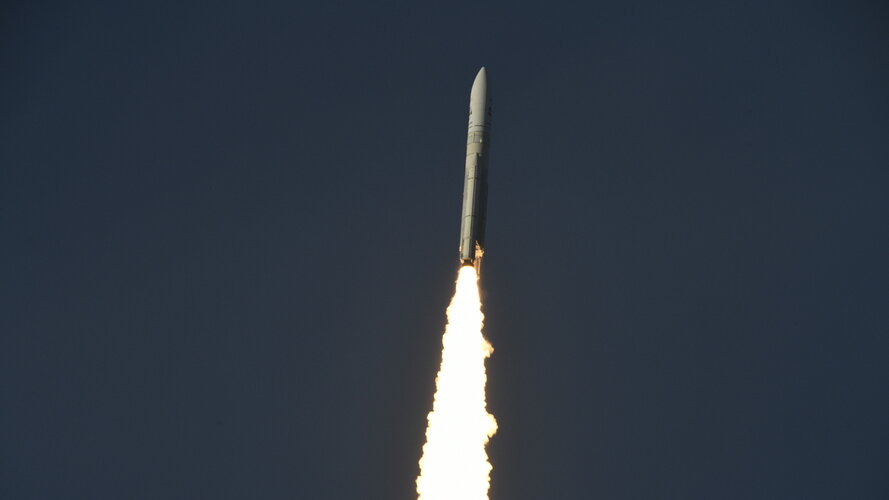 Video:
00:03:33
Video:
00:03:33
The first Meteosat Third Generation Imager (MTG-I1) satellite lifted off on an Ariane 5 rocket from Europe’s Spaceport in French Guiana on 13 December at 21:30 CET.
From geostationary orbit, 36,000 km above the equator, this all-new weather satellite will provide state-of-the art observations of Earth’s atmosphere and realtime monitoring of lightning events, taking weather forecasting to the next level. The satellite carries two completely new instruments: Europe’s first Lightning Imager and a Flexible Combined Imager.
MTG-I1 is the first of six satellites that form the full MTG system, which will provide critical data for weather forecasting over the next 20 years. In full operations, the mission will comprise two MTG-I satellites and one MTG Sounding (MTG-S) satellites working in tandem.
MTG-I1 lifts off
13.12.2022 21:45 Video:
00:03:33
Video:
00:03:33
The first Meteosat Third Generation Imager (MTG-I1) satellite lifted off on an Ariane 5 rocket from Europe’s Spaceport in French Guiana on 13 December at 21:30 CET.
From geostationary orbit, 36,000 km above the equator, this all-new weather satellite will provide state-of-the art observations of Earth’s atmosphere and realtime monitoring of lightning events, taking weather forecasting to the next level. The satellite carries two completely new instruments: Europe’s first Lightning Imager and a Flexible Combined Imager.
MTG-I1 is the first of six satellites that form the full MTG system, which will provide critical data for weather forecasting over the next 20 years. In full operations, the mission will comprise two MTG-I satellites and one MTG Sounding (MTG-S) satellites working in tandem.
Europe’s all-new weather satellite takes to the skies
13.12.2022 21:30 Image:
Europe’s all-new weather satellite takes to the skies
Image:
Europe’s all-new weather satellite takes to the skies
Europe’s all-new weather satellite takes to the skies
13.12.2022 21:30 Image:
Europe’s all-new weather satellite takes to the skies
Image:
Europe’s all-new weather satellite takes to the skies
Watch now: Meteosat Third Generation Imager-1 launch
13.12.2022 19:40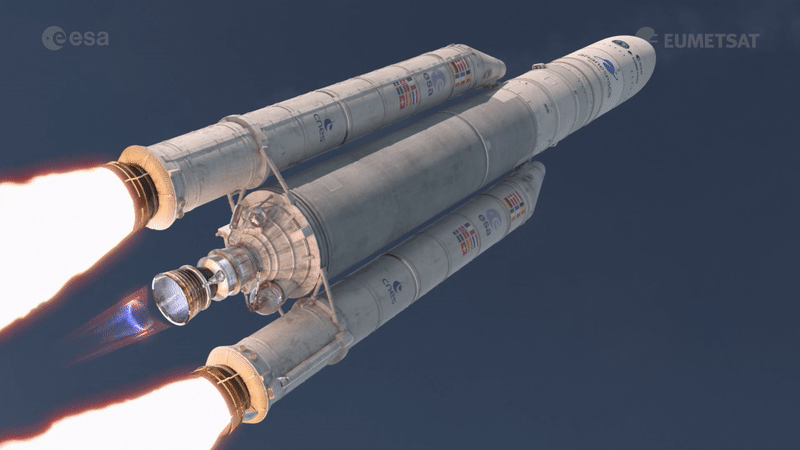
Watch now: Meteosat Third Generation Imager-1 launch
MTG-I1 rolled out and good to go
13.12.2022 10:40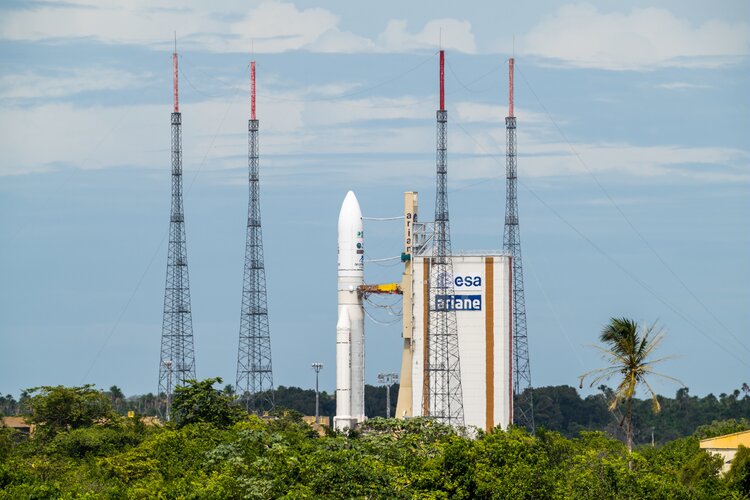
With liftoff set for today at 21:30 CET, the Ariane 5 rocket carrying the first Meteosat Third Generation Imager, MTG-I1, satellite is poised patiently on the launch pad at Europe’s Spaceport in French Guiana while the final checks are being carried out. Once in geostationary orbit, 36,000 km above the equator, this new satellite is set to herald a new era for meteorology.
Watch live launch of Meteosat Third Generation Imager-1
12.12.2022 8:50
On 13 December, the first of a new generation of satellites designed to revolutionise weather forecasting in Europe will take to the skies. ESA and the European Organisation for the Exploitation of Meteorological Satellites (Eumetsat) invite you to follow the live coverage for the launch of the first Meteosat Third Generation satellite starting from 19:40 CET on ESA Web TV.
MTG-I1 launch sequence in tune
9.12.2022 17:20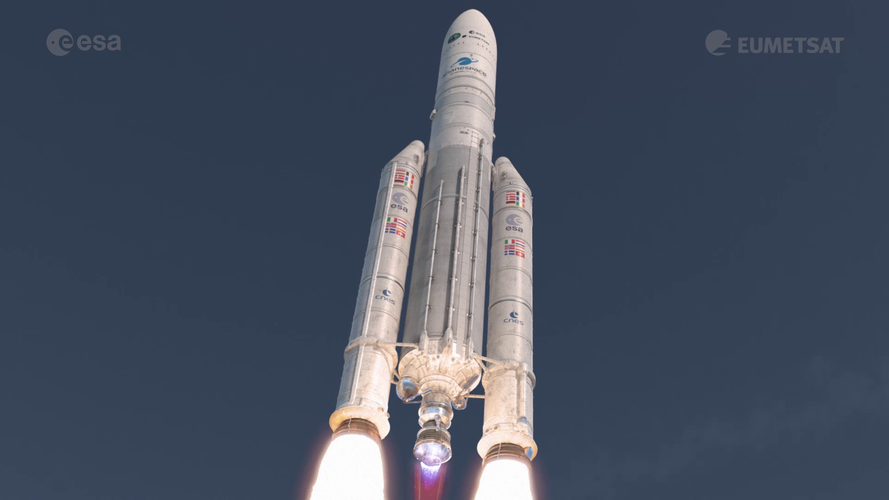 Video:
00:02:43
Video:
00:02:43
The animation shows the full launch sequence for the first Meteosat Third Generation Imager (MTG-I1) satellite. MTG-I1 launches on an Ariane 5 rocket from Europe’s Spaceport in Kourou, French Guiana.
MTG-I1 is the first of six satellites that form the full MTG system, which will provide critical data for weather forecasting over the next 20 years. In full operations, the mission will comprise two MTG-I satellites and one MTG Sounding (MTG-S) satellites working in tandem.
The MTG-I satellites carry two completely new instruments, a Flexible Combined Imager and Europe’s first Lightning Imager, to deliver high-quality data for better weather forecasting.
Earth from Space: Fucino, Italy
9.12.2022 10:00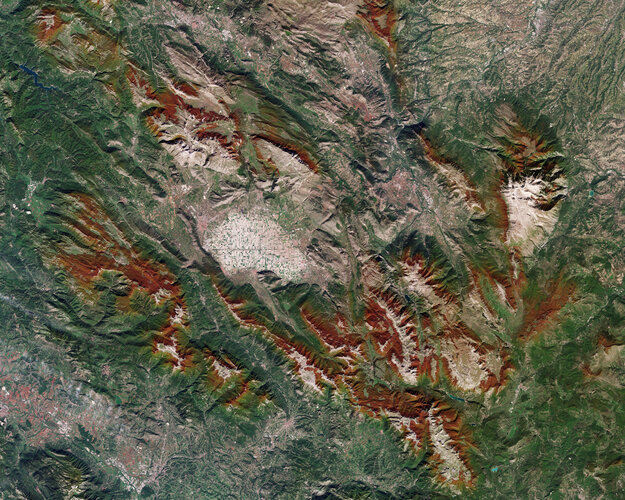
Tucked away in the Fucino Valley, in central Italy, lies the Fucino Space Centre, where Telespazio will manage the early orbit activities of the Meteosat Third Generation Imager, set to launch on 13 December from Europe’s Spaceport in French Guiana.
MTG-I1 never to be seen again
7.12.2022 16:17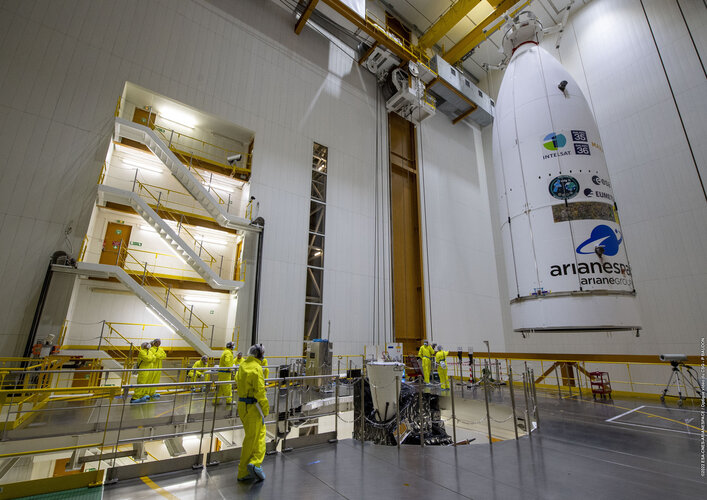
As preparations to launch Europe’s first Meteosat Third Generation Imager satellite continue, the team at Europe’s Spaceport in Kourou, French Guiana, has bid farewell to their precious satellite as it was sealed from view within the Ariane 5 rocket’s fairing. This all-new weather satellite is set to take to the skies on 13 December.
MTG-I1 never to be seen again
7.12.2022 16:17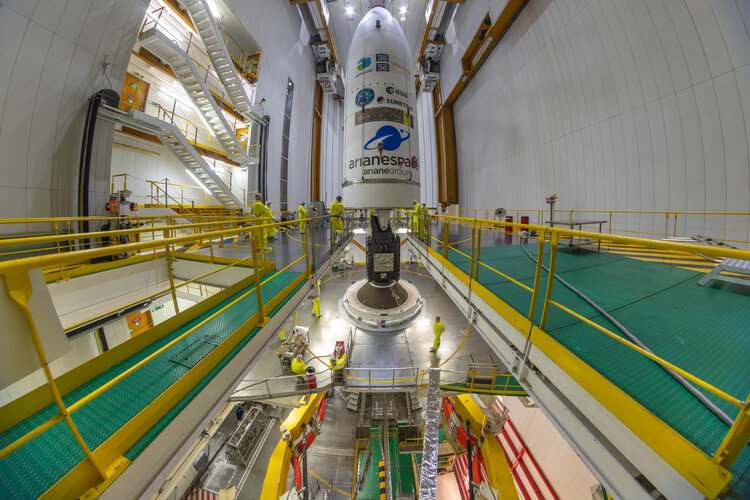
As preparations to launch Europe’s first Meteosat Third Generation Imager satellite continue, the team at Europe’s Spaceport in Kourou, French Guiana, has bid farewell to their precious satellite as it was sealed from view within the Ariane 5 rocket’s fairing. This all-new weather satellite is set to take to the skies on 13 December.
Launches secured for five Sentinel satellites
7.12.2022 14:47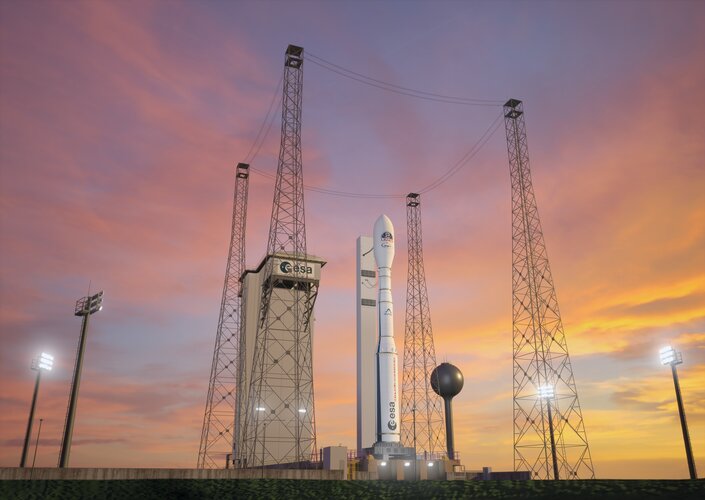
A contract signed today between ESA and Arianespace has ensured rides into orbit for five Copernicus Sentinels: Sentinel-1D, Sentinel-2C, Sentinel-3C, and the Copernicus Anthropogenic Carbon Dioxide-A and -B satellites. All the satellites will be launched on Vega-C rockets from Europe’s Spaceport in French Guiana and are scheduled to take place between 2024 and 2026.
Coming soon: MTG The Next Generation
6.12.2022 15:10 Video:
00:00:48
Video:
00:00:48
One week today, the first of a new generation of weather satellites will take to the skies. The Meteosat Third Generation system is the most complex and innovative meteorological satellite system ever built. It will bring new capabilities to monitor weather, climate and the environment from space like never before – promising to further bolster Europe’s leadership in weather forecasting.
Join us for the live launch coverage of the Metetosat Third Generation Imager on 13 December on ESA Web TV.
Animations provided by Mlabspace
Coming soon: MTG The Next Generation
6.12.2022 15:10 Video:
00:00:48
Video:
00:00:48
One week today, the first of a new generation of weather satellites will take to the skies. The Meteosat Third Generation system is the most complex and innovative meteorological satellite systems ever built. It will bring new capabilities to monitor weather, climate and the environment from space like never before – promising to further bolster Europe’s leadership in weather forecasting.
Join us for the live launch coverage of the Metetosat Third Generation Imager on 13 December on ESA Web TV.
Coming soon: MTG The Next Generation
6.12.2022 15:10 Video:
00:00:48
Video:
00:00:48
One week today, the first of a new generation of weather satellites will take to the skies. The Meteosat Third Generation system is the most complex and innovative meteorological satellite system ever built. It will bring new capabilities to monitor weather, climate and the environment from space like never before – promising to further bolster Europe’s leadership in weather forecasting.
Join us for the live launch coverage of the Metetosat Third Generation Imager on 13 December on ESA Web TV.
Replay: MTG-I1 pre-launch briefing
5.12.2022 15:51 Video:
00:00:00
Video:
00:00:00
Watch the replay of the Meteosat Third Generation Imager-1 pre-launch press briefing held on 5 December 2022. Speakers include Simonetta Cheli, ESA’s Director of Earth Observation Programmes; Phil Evans, Director General of Eumetsat; Bertrand Denis, Vice President Observation and Science at Thales Alenia Space and Simon Keogh, Head of Space Applications and Nowcasting Research & Development at the UK Met Office.
MTG-I1 is scheduled to be launched on 13 December on an Ariane 5 rocket from Europe’s Spaceport in French Guiana. It is the first of six satellites that form the full MTG system, which will provide critical data for weather forecasting over the next 20 years. In full operations, the mission will comprise two MTG-I satellites and one MTG Sounding (MTG-S) satellites working in tandem.
The MTG-I satellites carry two completely new instruments, a Flexible Combined Imager and Europe’s first Lightning Imager, to deliver high-quality data for better weather forecasting.
Replay: MTG-I1 pre-launch briefing
5.12.2022 15:51 Video:
00:43:38
Video:
00:43:38
Watch the replay of the Meteosat Third Generation Imager-1 pre-launch press briefing held on 5 December 2022. Speakers include Simonetta Cheli, ESA’s Director of Earth Observation Programmes; Phil Evans, Director General of Eumetsat; Bertrand Denis, Vice President Observation and Science at Thales Alenia Space and Simon Keogh, Head of Space Applications and Nowcasting Research & Development at the UK Met Office.
MTG-I1 is scheduled to be launched on 13 December on an Ariane 5 rocket from Europe’s Spaceport in French Guiana. It is the first of six satellites that form the full MTG system, which will provide critical data for weather forecasting over the next 20 years. In full operations, the mission will comprise two MTG-I satellites and one MTG Sounding (MTG-S) satellites working in tandem.
The MTG-I satellites carry two completely new instruments, a Flexible Combined Imager and Europe’s first Lightning Imager, to deliver high-quality data for better weather forecasting.
Replay: MTG-I1 pre-launch briefing
5.12.2022 15:51 Video:
00:43:38
Video:
00:43:38
Watch the replay of the Meteosat Third Generation Imager-1 pre-launch press briefing held on 5 December 2022. Speakers include Simonetta Cheli, ESA’s Director of Earth Observation Programmes; Phil Evans, Director General of Eumetsat; Bertrand Denis, Vice President Observation and Science at Thales Alenia Space and Simon Keogh, Head of Space Applications and Nowcasting Research & Development at the UK Met Office.
MTG-I1 is scheduled to be launched on 13 December on an Ariane 5 rocket from Europe’s Spaceport in French Guiana. It is the first of six satellites that form the full MTG system, which will provide critical data for weather forecasting over the next 20 years. In full operations, the mission will comprise two MTG-I satellites and one MTG Sounding (MTG-S) satellites working in tandem.
The MTG-I satellites carry two completely new instruments, a Flexible Combined Imager and Europe’s first Lightning Imager, to deliver high-quality data for better weather forecasting.
Watch now: MTG-I1 pre-launch press briefing
5.12.2022 15:15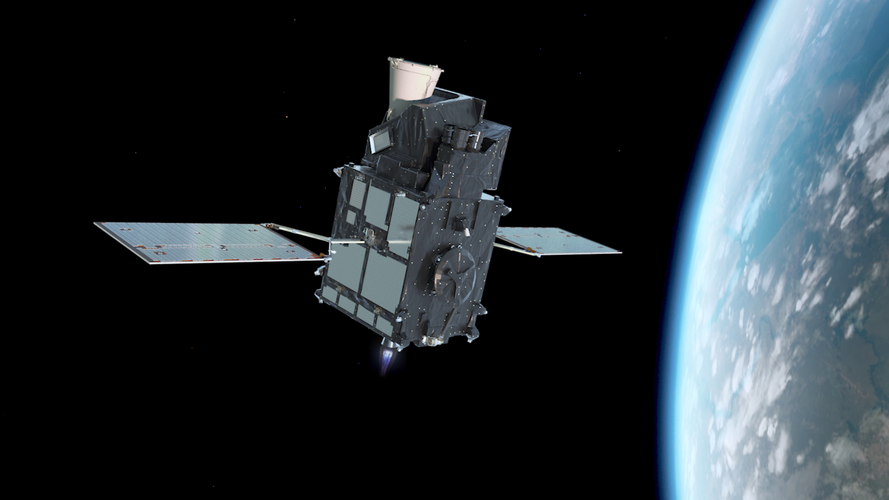
Watch now: MTG-I1 pre-launch press briefing
Green City Makers wins top prize at Copernicus Masters
2.12.2022 12:06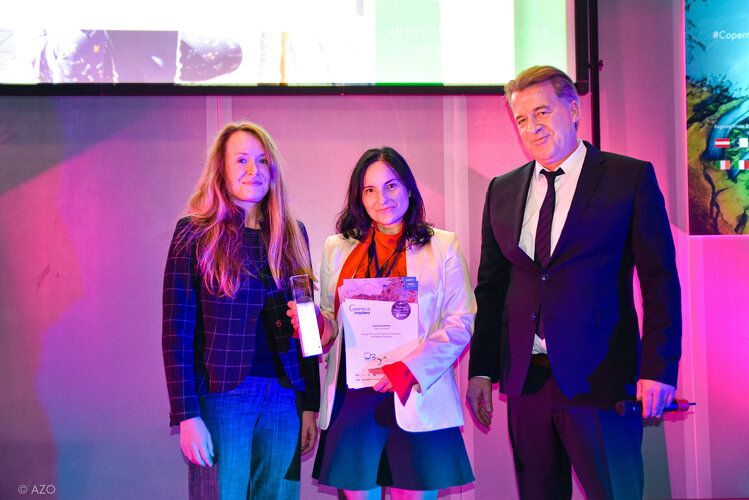
Green City Makers wins top prize at Copernicus Masters
Earth from Space: the moraines of Malaspina
2.12.2022 10:00
The remarkable moraine patterns of Malaspina Glacier – the largest piedmont glacier in the world – are featured in this false-colour image acquired by Copernicus Sentinel-2.
Media invitation: Meteosat Third Generation Imager-1 launch
29.11.2022 11:15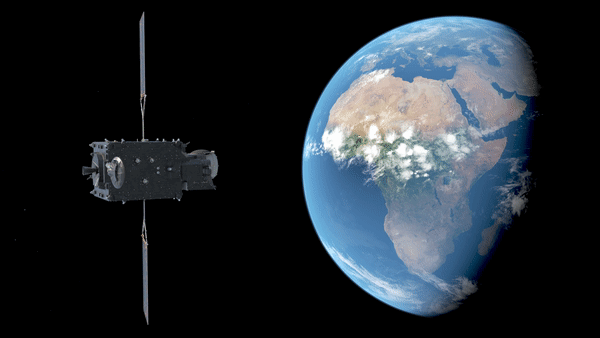
Media invitation: Meteosat Third Generation Imager-1 launch
Glacier calving and a whole lot of mixing
29.11.2022 8:00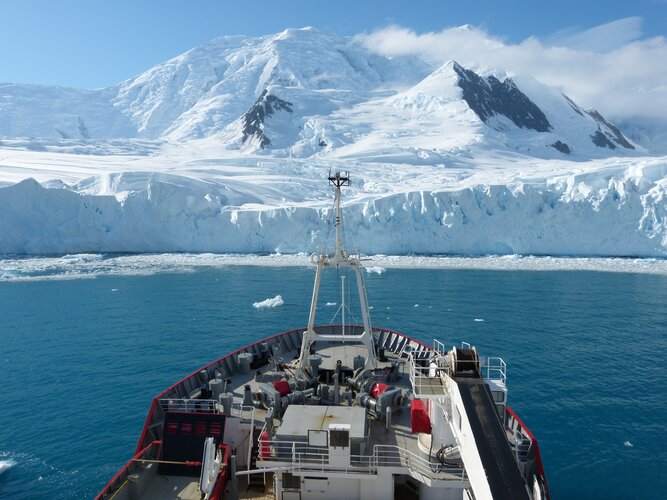
It’s no surprise that when a massive lump of ice drops off the edge of a glacier into the sea, the surface waters of the ocean get pretty churned up. However, in addition to causing tsunamis at the surface of the ocean, recent research has led to the discovery that glacier calving can excite vigorous internal tsunami waves – a process that has been neglected in driving ocean mixing in computer models.
New weather satellite fully loaded
28.11.2022 7:52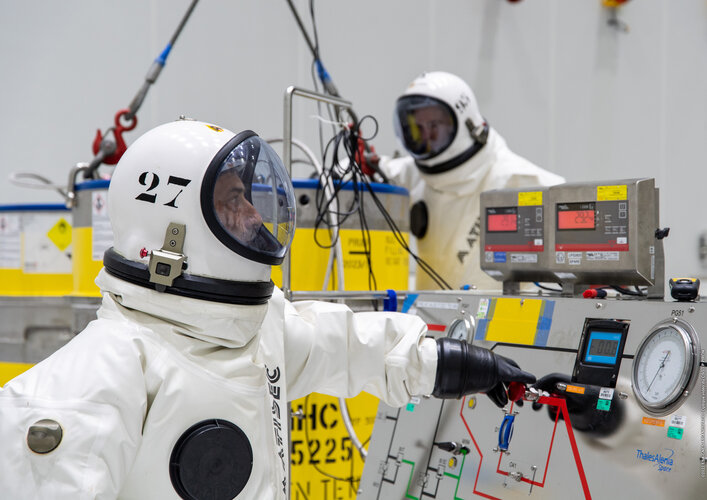
With liftoff now scheduled for 13 December, Europe’s first Meteosat Third Generation Imager (MTG-I1) satellite has been fuelled – a critical and extremely hazardous milestone on the road to launch. Once in geostationary orbit 36,000 km above the equator, this all-new weather satellite will provide state-of-the art observations of Earth’s atmosphere and realtime monitoring of lightning events, taking weather forecasting to the next level.
Locked and loaded
28.11.2022 7:52
With liftoff now scheduled for 13 December, Europe’s first Meteosat Third Generation Imager (MTG-I1) satellite has been fuelled – a critical and extremely hazardous milestone on the road to launch. Once in geostationary orbit 36,000 km above the equator, this all-new weather satellite will provide state-of-the art observations of Earth’s atmosphere and realtime monitoring of lightning events, taking weather forecasting to the next level.
Earth from Space: Zaragoza, Spain
25.11.2022 10:00
The province of Zaragoza, in northeast Spain, is featured in this image captured by the Copernicus Sentinel-2 mission.
Watch live: ESA Council Meeting at Ministerial Level
21.11.2022 11:01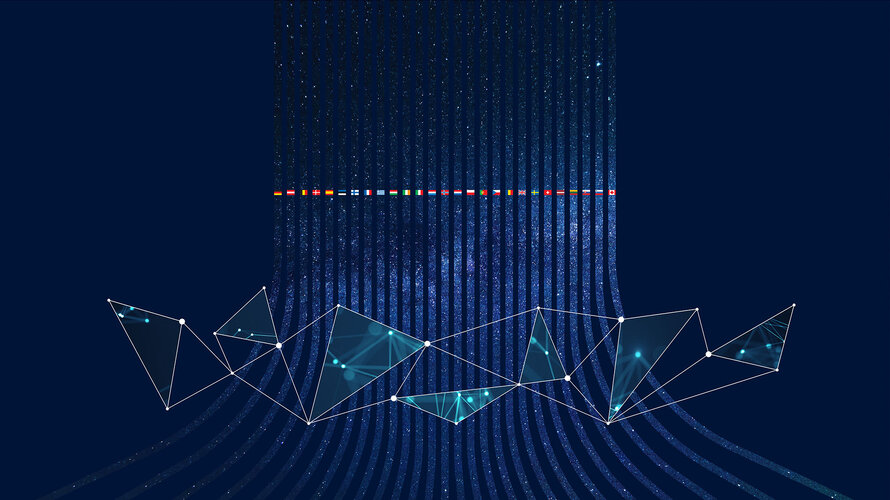
The ESA Council at Ministerial level (CM22) is taking place in Paris, France, on 22 and 23 November. ESA’s Member States, Associated States and Cooperating States will be invited to together strengthen Europe’s space ambitions and ensure that space continues to serve European citizens. Follow our live coverage of CM22 via ESA WebTV.
Watch live: ESA Council meeting at Ministerial level
21.11.2022 11:01
The ESA Council at Ministerial level (CM22) is taking place in Paris, France, on 22 and 23 November. ESA’s Member States, Associate Members and Cooperating States will be invited to together strengthen Europe’s space ambitions and ensure that space continues to serve European citizens. Follow our live coverage of CM22 via ESA WebTV.
Putting a value on ESA’s Aeolus wind mission
18.11.2022 13:20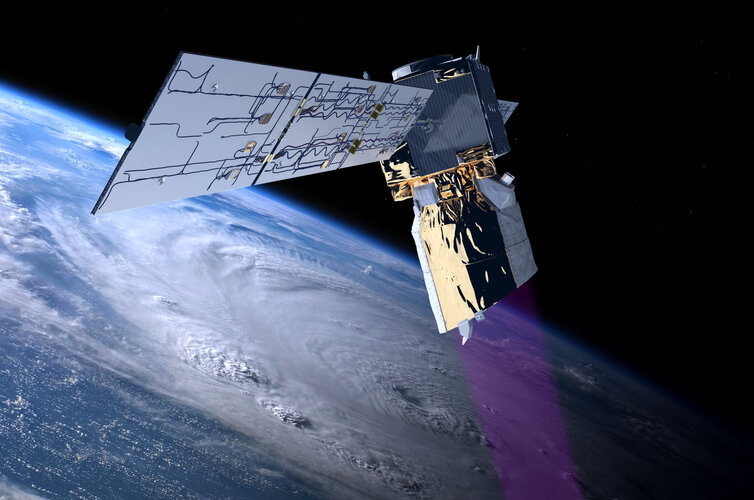
Over the last four years, ESA’s Aeolus mission has been delivering unique profiles of Earth’s winds from space, improving operational weather forecasts, climate models and more – all showing that its novel laser technology is advancing science and being used for important practical applications. Adding to the list of Aeolus’ successes, a recent report highlights that the mission has also brought economics benefits to Europe to the tune of €3.5 billion, and that a follow-on mission could more than double this figure.
Earth from Space: Sharm El-Sheikh, Egypt
18.11.2022 10:00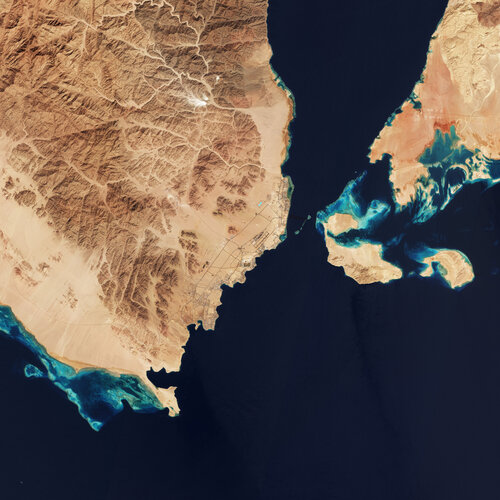
World leaders, policymakers and delegates from nearly 200 countries have convened in Sharm El-Sheikh over the past two weeks at the COP27 UN Climate Summit. Today we take a closer look at the Egyptian city through the eyes of Copernicus Sentinel-2.
Strengthening InCubed’s role in commercial Earth observation
17.11.2022 15:00
Commercialisation is universally recognised as essential for the future prosperity of all aspects of the European space sector, and Earth observation is no exception. The ESA InCubed programme, a co-funding initiative that helps entrepreneurs bring their innovative ideas to market, has enjoyed enormous success since the launch of its first activity in 2018 and continues to make a prodigious contribution to commercial Earth observation. The InCubed portfolio includes around 60 activities, with an impressive €63 million invested so far.
At the upcoming ESA Council at Ministerial Level, Member States will have the possibility to further empower InCubed in its far-reaching efforts to foster commercial innovation. The programme proposal makes the case for a wider remit, including a set of new ‘Invest Actions’ designed to help boost the European Earth observation economy and reinforce relationships with the private investor community.
Pushing the boundaries of space
16.11.2022 13:30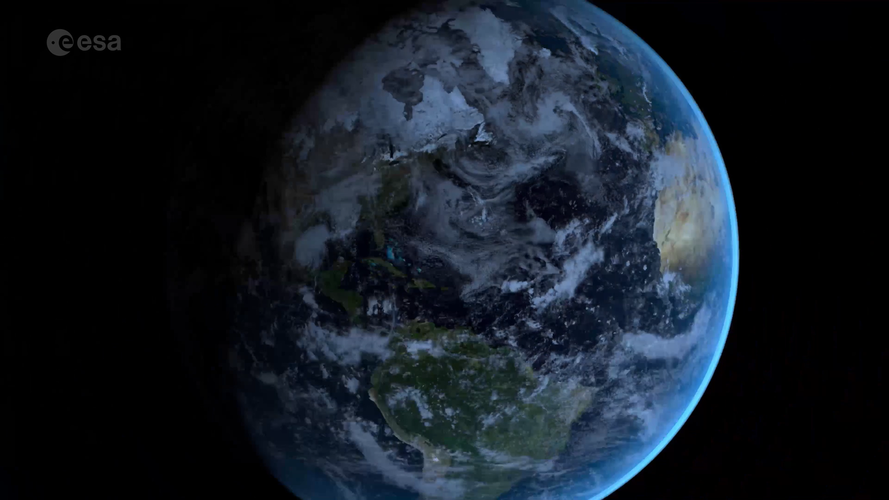 Video:
00:02:02
Video:
00:02:02
Space is delivering more accurate, more precise and more varied data than ever before. State-of-the-art digital technologies, such as Digital Twins of Earth and High Performance Computing, are enabling faster and more complex calculations, allowing us to replicate the Earth system, its climate and life on our planet.
ESA is exploiting digital technologies and artificial intelligence, supporting scientists and industry to respond to global challenges such as the climate crisis and designing innovative solutions for our future.
ESA’s Council at Ministerial level, CM22, taking place next week is a time for critical decisions. Space supports scientists, policymakers and political leaders not only to monitor, understand, model and predict, but – crucially – to act on climate-induced and other crises.
Earth observation data allows institutions, the scientific community, citizens and industry to harness space data for their use – paving the way for a sustainable and green future for all.
Pushing the boundaries of space
16.11.2022 13:30 Video:
00:02:02
Video:
00:02:02
Space is delivering more accurate, more precise and more varied data than ever before. State-of-the-art digital technologies, such as Digital Twins of Earth and High Performance Computing, are enabling faster and more complex calculations, allowing us to replicate the Earth system, its climate and life on our planet.
ESA is exploiting digital technologies and artificial intelligence, supporting scientists and industry to respond to global challenges such as the climate crisis and designing innovative solutions for our future.
ESA’s Council at Ministerial level, CM22, taking place next week is a time for critical decisions. Space supports scientists, policymakers and political leaders not only to monitor, understand, model and predict, but – crucially – to act on climate-induced and other crises.
Earth observation data allows institutions, the scientific community, citizens and industry to harness space data for their use – paving the way for a sustainable and green future for all.
Sentinel-5P data used in new methane detection system
16.11.2022 10:00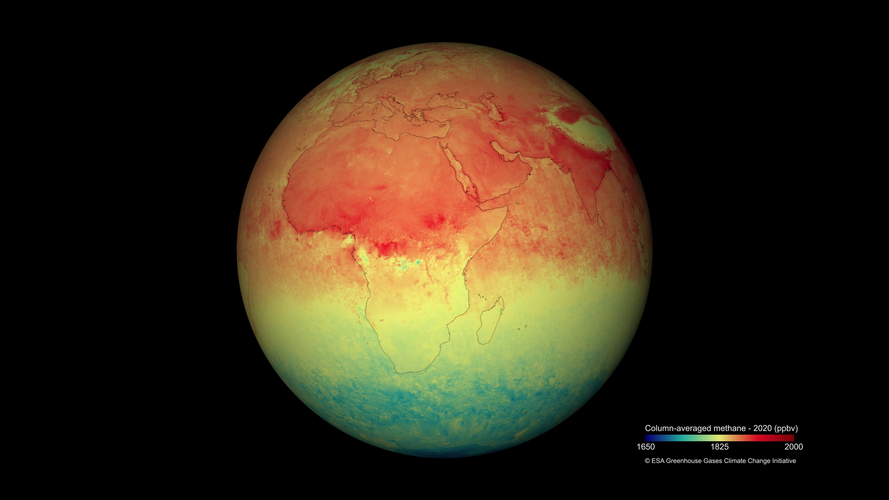
As part of worldwide efforts to slow climate change, the United Nations has revealed a new satellite-based system to detect methane emissions. The Methane Alert and Response System (MARS) initiative, launched at COP27, will scale up global efforts to detect and act on major emissions sources and accelerate the implementation of the Global Methane Pledge.
The Sentinel-5P satellite, the first Copernicus mission dedicated to monitoring our atmosphere, will be crucial in implementing this ambitious initiative.
ESA Extremes
15.11.2022 10:50 Image:
ESA is Europe’s space agency, enabling its 22 Member States to achieve results in space that no individual nation can match. Covering every aspect of space, from exploration to Earth observation to telecommunications and navigation, this potent formula has chalked up several extreme achievements for Europe. Here are a select few out of many:
Image:
ESA is Europe’s space agency, enabling its 22 Member States to achieve results in space that no individual nation can match. Covering every aspect of space, from exploration to Earth observation to telecommunications and navigation, this potent formula has chalked up several extreme achievements for Europe. Here are a select few out of many:
Strong European support for space to combat climate crisis
15.11.2022 9:20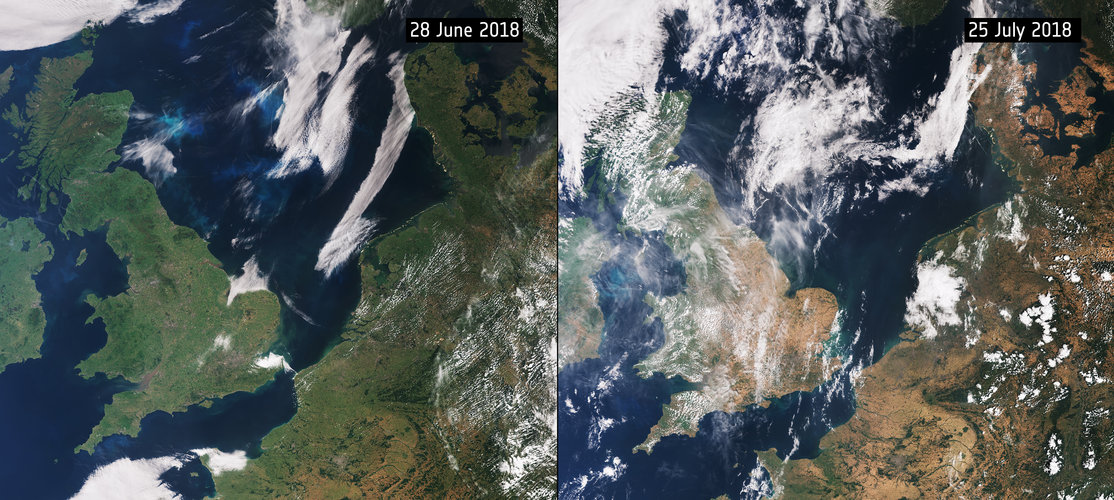
Europe should demonstrate responsibility, leadership and autonomy in space – and its highest priority should be to address climate change, according to a poll of European citizens.
Results from ESA’s Climate Change Initiative on display at COP27
14.11.2022 17:00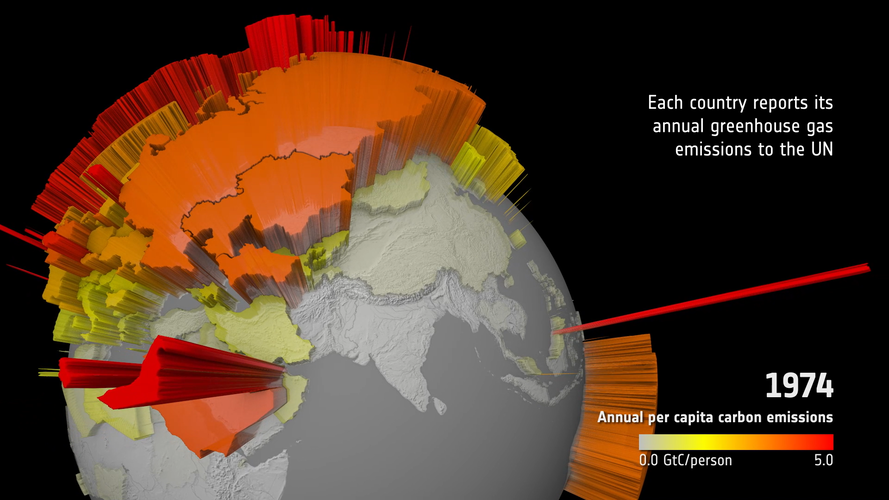
Achieving net-zero by the second half of the century is considered vital if global temperatures are to remain well below the two degrees rise as set out by the Paris Agreement for climate. From their vantage point in space, satellites provide a unique means of tracking progress towards achieving this balance between greenhouse gas emissions from sources and removal by sinks.
How space-based approaches can support the UN Global stocktake, starting in 2023, are the focus of technical discussions at the 2022 United Nations Climate Change Conference (COP27) currently taking place in Sharm El-Sheikh, and feature results from ESA’s trailblazing REgional Carbon Cycle Assessment and Processes project. These results come at a critical time ahead of next week’s ESA Council Meeting at Ministerial Level.
ESA results on display at COP27
14.11.2022 17:00
Achieving net-zero by the second half of the century is considered vital if global temperatures are to remain well below the two degrees rise as set out by the Paris Agreement for climate. From their vantage point in space, satellites provide a unique means of tracking progress towards achieving this balance between greenhouse gas emissions from sources and removal by sinks.
How space-based approaches can support the UN Global stocktake, starting in 2023, are the focus of technical discussions at the 2022 United Nations Climate Change Conference (COP27) currently taking place in Sharm El-Sheikh, and feature results from ESA’s trailblazing REgional Carbon Cycle Assessment and Processes project. These results come at a critical time ahead of next week’s ESA Council Meeting at Ministerial Level.
Biomass heads for the shaker
14.11.2022 16:53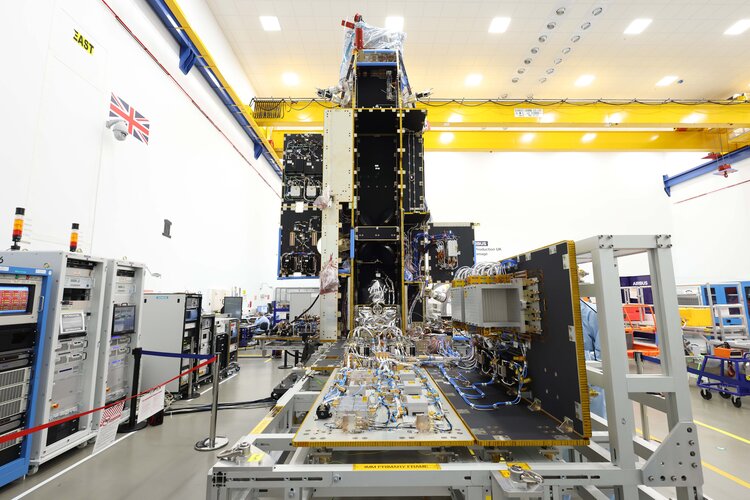
Over the last six months, engineers at Airbus in Stevenage, UK, and teams from Europe and North America have turned a multitude of structural parts and electronic units into a complete satellite: ESA’s Biomass satellite. Now complete, this brand-new satellite has been shipped to Airbus’ testing facility in Toulouse, France, where it will be put through its paces to ensure that it will survive the rigours of liftoff and the harsh environment of space to deliver on its promise, that being to yield new insight into Earth’s precious forests.
Earth from Space: Santiago, Chile
11.11.2022 10:00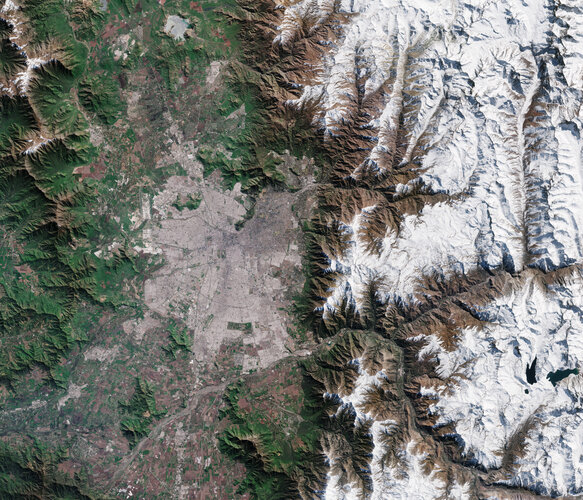
The Copernicus Sentinel-2 mission captured this image of Santiago – the capital and largest city of Chile.
Call for Media: launch of the first Meteosat Third Generation satellite MTG-I1
8.11.2022 9:37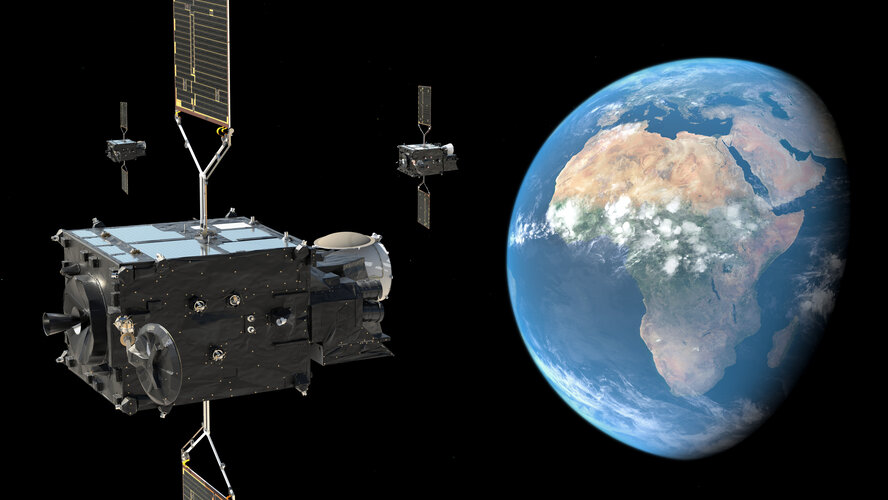
Call for Media: launch of the first MTG satellite MTG-I1
Earth from Space: Nushagak Bay, Alaska
4.11.2022 10:00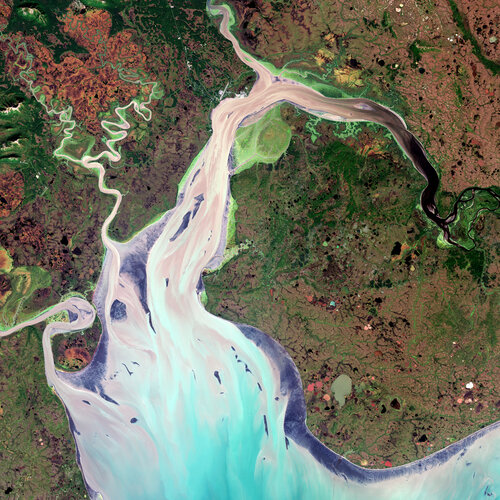
The complex and diverse landscape that surrounds Nushagak Bay in Alaska is featured in this true-colour image captured by the Copernicus Sentinel-2 mission.
Earth Observation Excellence Award deadline approaching
3.11.2022 10:45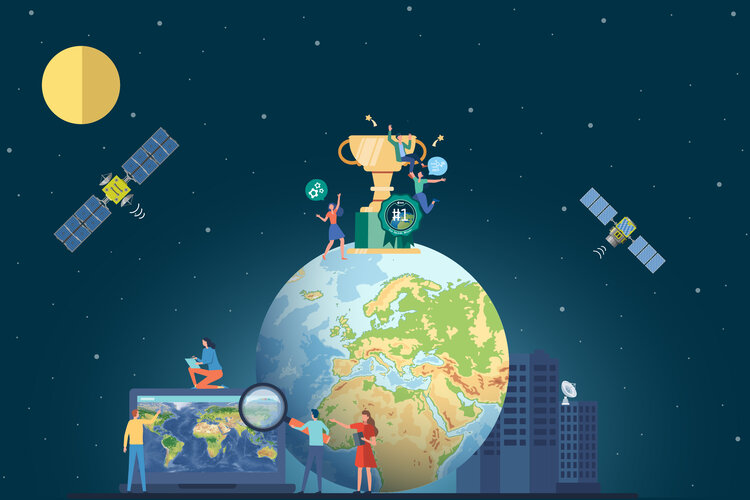
In a little over a month, the window of opportunity for nominating deserving scientists for the prestigious ESA-EGU Earth Observation Excellence Award will close. With the period for lodging nominations closing on 7 December, past nominators and winners reflect on how this award has increased the visibility of their scientific research and opened new avenues to working partnerships.
Give climate some MAGIC
31.10.2022 15:44
There are times when we could all do with a bit of magic in our lives. And, with the Global Climate Observing System announcement of ‘terrestrial water storage’ as a completely new Essential Climate Variable, the world of climate research and climate crisis response would certainly benefit from a satellite mission called MAGIC.
Earth from Space: Svalbard
28.10.2022 10:00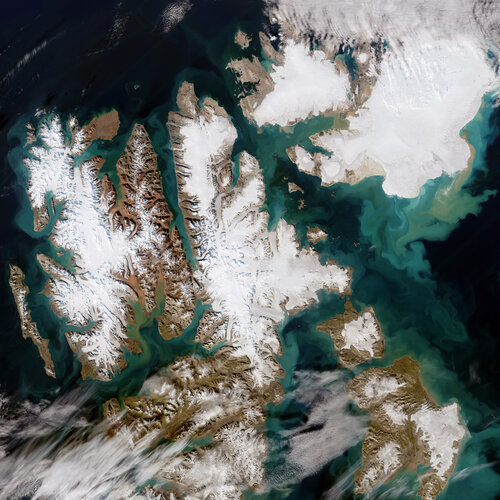
Extremely high temperatures recorded this summer caused record melting across Svalbard – one of the fastest warming places on the planet. The Copernicus Sentinel-2 mission captured this rare, cloud-free acquisition of the Norwegian archipelago in August 2022.
Earth from Space: Svalbard
28.10.2022 10:00
Extremely high temperatures recorded this summer caused record melting across Svalbard – one of the fastest warming places on the planet. The Copernicus Sentinel-2 mission captured this rare, cloud-free acquisition of the Norwegian archipelago in August 2022.
From Rome to Cannes
25.10.2022 8:45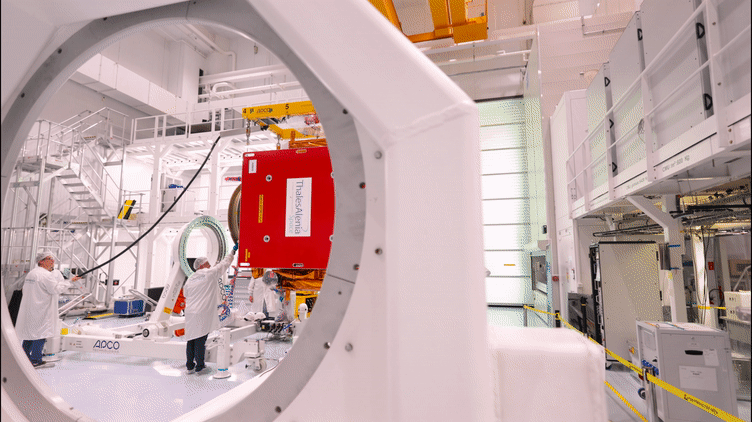
The Copernicus Sentinel-1C satellite is currently in Cannes undergoing a series of demanding tests in preparation for launch in 2023. The third member of the Sentinel-1 radar family, part of Europe’s Copernicus programme, will continue the critical task of delivering key radar imagery of Earth’s surface for a wide range of services and scientific applications.
Boosting Earth science
24.10.2022 13:47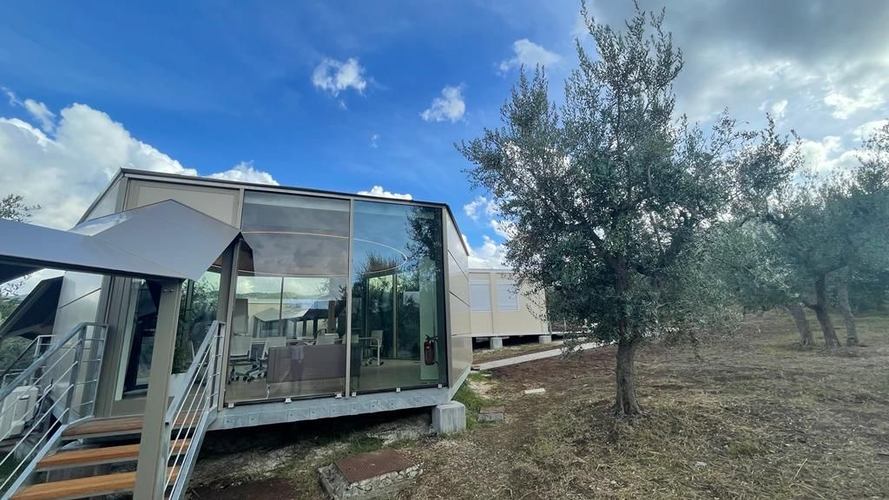
With science at the core of the Earth Observation FutureEO programme, ESA has opened a new scientific facility, the Science Hub, which offers new opportunities for collaborative research to further boost the Agency’s and its Member States scientific output.
The scary sound of Earth’s magnetic field
24.10.2022 8:00
Despite being essential to life on Earth, the magnetic field isn’t something we can actually see in itself, or ever hear. But, remarkably, scientists at the Technical University of Denmark have taken magnetic signals measured by ESA’s Swarm satellite mission and converted them into sound – and for something that protects us, the result is pretty scary.
Earth from Space: Inhambane Bay, Mozambique
21.10.2022 10:00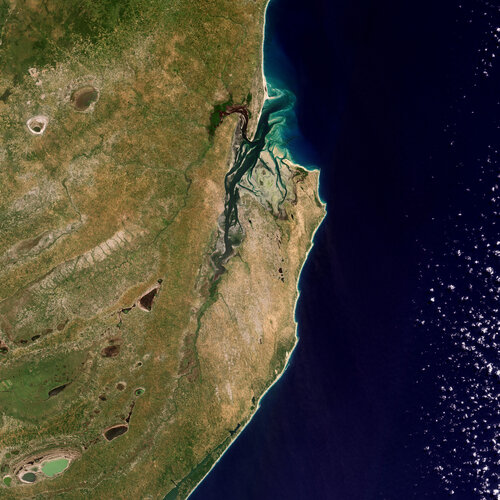
Inhambane Bay, in southeast Mozambique, is featured in this true-colour image captured by the Copernicus Sentinel-2 mission.
Europe’s all-new weather satellite arrives at launch site
18.10.2022 10:30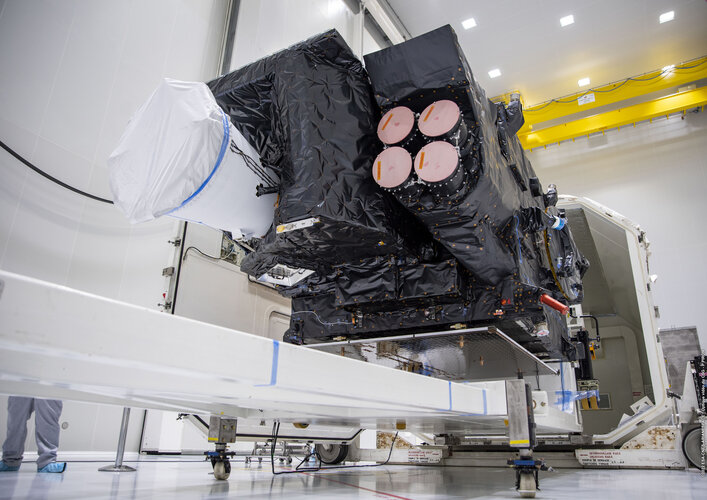
After a two-week voyage across the Atlantic Ocean, the ship transporting the first Meteosat Third Generation satellite docked at Pariacabo in French Guiana and the precious cargo unloaded. Now safe and sound in one of the spaceport’s cleanrooms, satellite engineers will ready it for liftoff on an Ariane 5 rocket in December. Once in geostationary orbit, this new satellite, which carries two new extremely sensitive instruments, promises to further bolster Europe's leadership in weather forecasting.
Earth from Space: Mississippi River
14.10.2022 10:00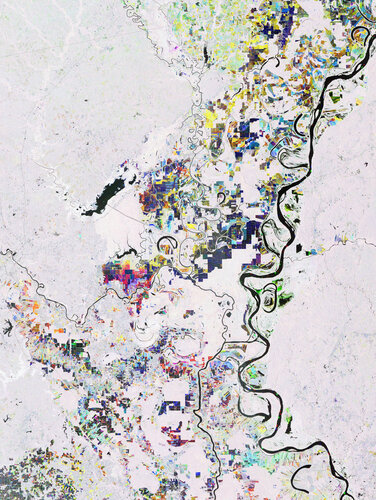
Mississippi River, one of the longest rivers in North America, is featured in this multi-temporal radar image captured by the Copernicus Sentinel-1 mission.
Earth from Space: Mississippi River
14.10.2022 10:00
Mississippi River, one of the longest rivers in North America, is featured in this multi-temporal radar image captured by the Copernicus Sentinel-1 mission.
Seasonal changes in Antarctic ice sheet flow dynamics detected for the first time
12.10.2022 11:00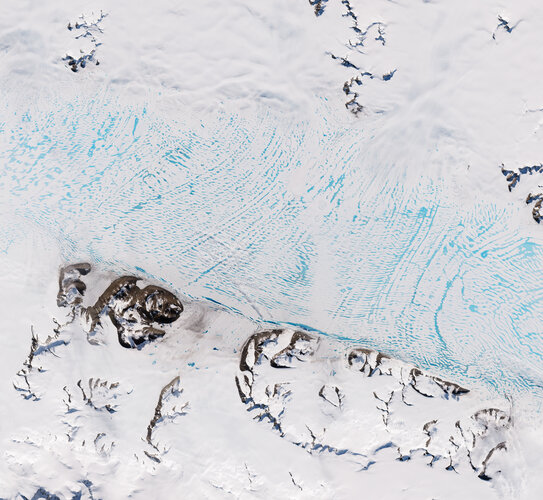
Certain estimates of Antarctica’s total contribution to sea-level rise may be over, or even underestimated, after researchers detected a previously unknown source of ice loss variability. In a new paper published in The Cryosphere, researchers using Copernicus Sentinel-1 data, found that glaciers feeding the George VI Ice Shelf speed up by approximately 15% during the Antarctic summer. This is the first time that such seasonal cycles have been detected on land ice flowing into ice shelves in Antarctica.
Italy’s Stromboli erupts
10.10.2022 16:00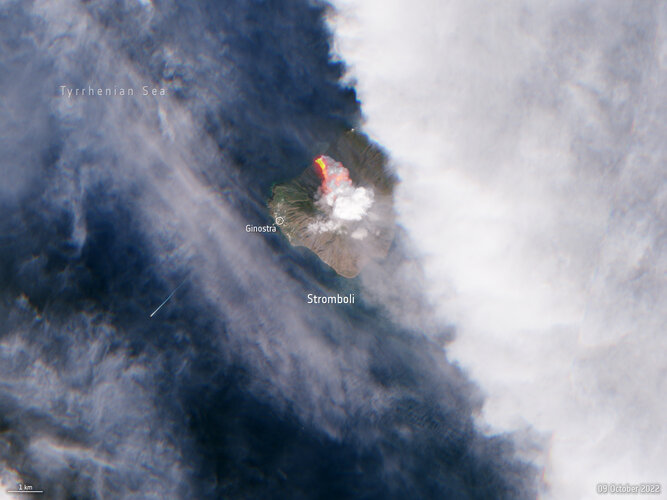 Image:
A volcano on the Italian island of Stromboli erupted early on Sunday morning, releasing huge plumes of smoke and a lava flow pouring into the sea. The Copernicus Sentinel-2 mission captured this image of the aftermath less than five hours after the eruption.
Image:
A volcano on the Italian island of Stromboli erupted early on Sunday morning, releasing huge plumes of smoke and a lava flow pouring into the sea. The Copernicus Sentinel-2 mission captured this image of the aftermath less than five hours after the eruption.
TRUTHS on the table at ESA’s Ministerial Council
10.10.2022 14:45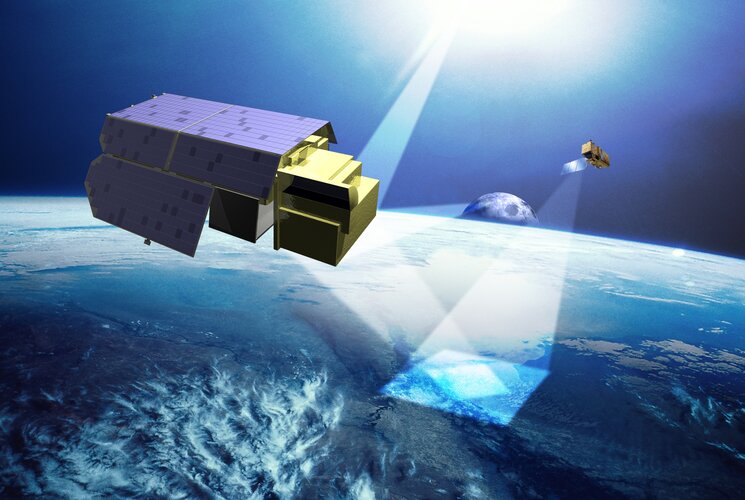
With the satellite and instrument design consolidated and the scientific community assured it will deliver the data they need, TRUTHS has been approved as part of Earth Observation Programme proposal for the upcoming ESA Council Meeting at Ministerial Level. Carrying a primary International System of Units reference system, TRUTHS promises to set the gold standard for climate measurements.
Earth observation inspires global inventiveness
10.10.2022 11:35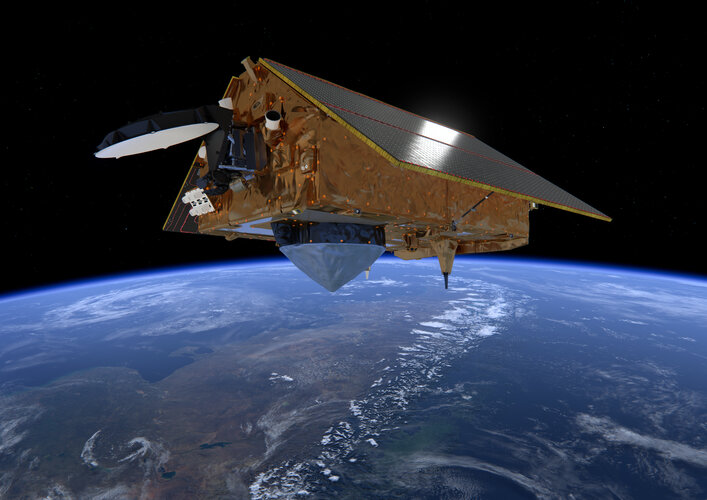
Today our home planet Earth is being more closely monitored than at any time in its history. Some 1 460 Earth-observing satellites have been launched during the last two decades, with Europe’s Copernicus Sentinel fleet in the forefront of environmental data gathering. A new report led by the European Patent Office examining associated patent filings reveals a 1 800% increase in the same period – with European activity comparatively stagnant compared to international competitors.
Earth from Space: Bouches-du-Rhône
7.10.2022 10:00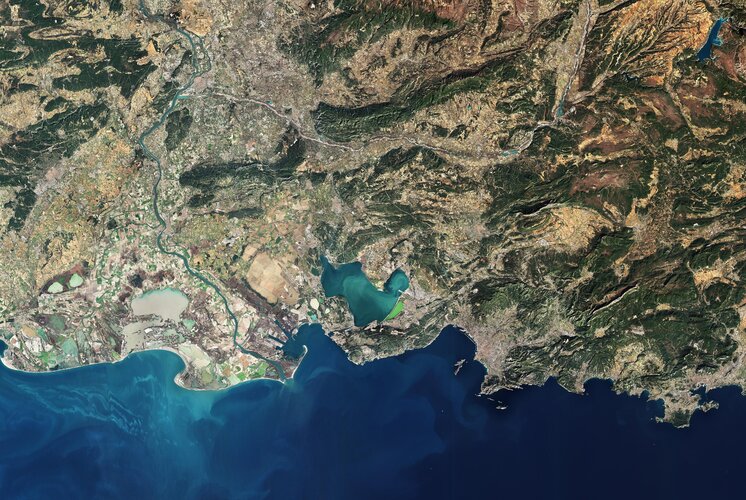
The port town of Fos-Sur-Mer, in the southern part of Bouches-du-Rhône, France, is featured in this image captured by Copernicus Sentinel-2. It is from here where the first Meteosat Third Generation Imager satellite set sail last week on its journey to Europe’s Spaceport in French Guiana.
Earth from Space: Bouches-du-Rhône
7.10.2022 10:00
The port town of Fos-Sur-Mer, in the southern part of Bouches-du-Rhône, France, is featured in this image captured by Copernicus Sentinel-2. It is from here where the first Meteosat Third Generation Imager satellite set sail last week on its journey to Europe’s Spaceport in French Guiana.
Satellites detect methane plume in Nord Stream leak
6.10.2022 10:02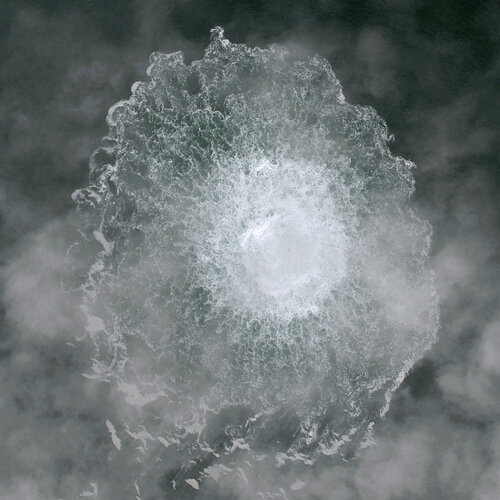
Following unusual seismic disturbances in the Baltic Sea, several leaks were discovered last week in the underwater Nord Stream 1 and 2 gas pipelines, near Denmark and Sweden. Neither pipeline was transporting gas at the time of the blasts, but they still contained pressurised methane – the main component of natural gas – which spewed out producing a wide stream of bubbles on the sea surface.
With the unexplained gas release posing a serious question about the incident’s environmental impact, a suite of complementary Earth observation satellites carrying optical and radar imaging instruments were called upon to characterise the gas leak bubbling in the Baltic.
Europe’s new weather satellite sets sail
30.9.2022 10:45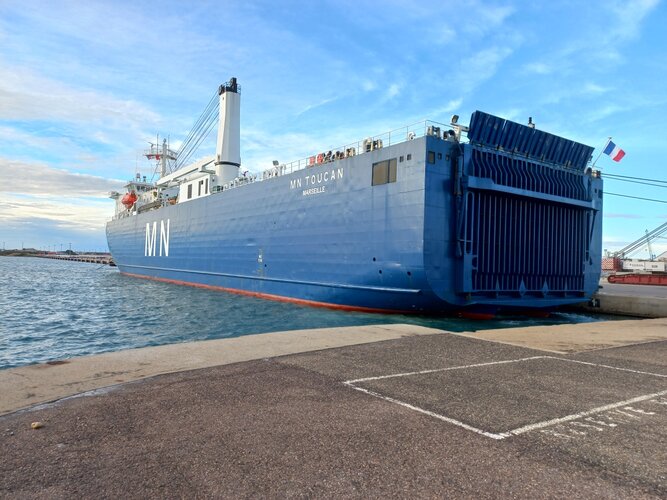
The first of Europe’s Meteosat Third Generation satellites is now safely aboard a ship and making its way across the Atlantic to French Guiana where it will be readied for liftoff in December. Once launched into geostationary orbit, 36 000 km above Earth, this new satellite, which carries two new extremely sensitive instruments, will take weather forecasting to the next level.
Europe’s new weather satellite sets sail
30.9.2022 10:45
The first of Europe’s Meteosat Third Generation satellites is now safely aboard a ship and making its way across the Atlantic to French Guiana where it will be readied for liftoff in December. Once launched into geostationary orbit, 36 000 km above Earth, this new satellite, which carries two new extremely sensitive instruments, will take Europe's leadership in weather forecasting to the next level.
Earth from Space: Melt ponds in West Greenland
30.9.2022 10:00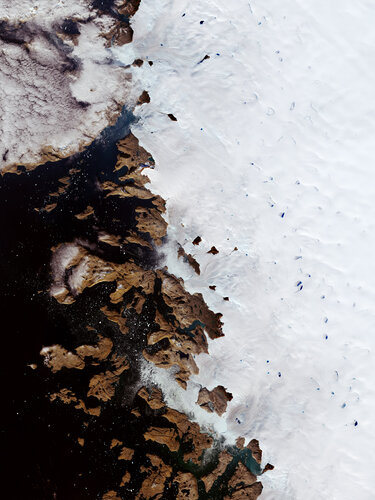
During spring and summer, as the air warms up and the sun beats down on the Greenland Ice Sheet, melt ponds pop up. Melt ponds are vast pools of open water that form on both sea ice and ice sheets and are visible as turquoise-blue pools of water in this Copernicus Sentinel-2 image.
Earth from Space: Melt ponds in West Greenland
30.9.2022 10:00
During spring and summer, as the air warms up and the sun beats down on the Greenland Ice Sheet, melt ponds pop up. Melt ponds are vast pools of open water that form on both sea ice and ice sheets and are visible as turquoise-blue pools of water in this Copernicus Sentinel-2 image.
New weather satellite on its way to launch
30.9.2022 9:00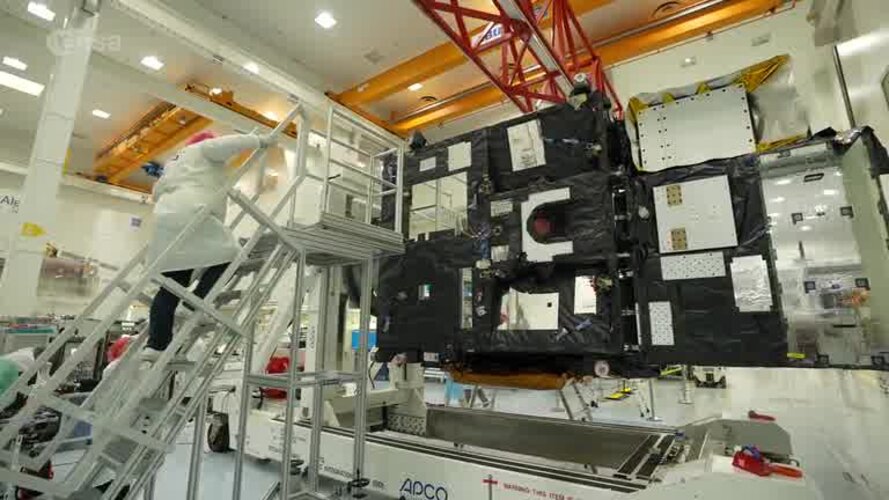 Video:
00:04:04
Video:
00:04:04
The final pre-launch preparations for the first Meteosat Third Generation (MTG) satellite are underway. The first satellite, called MTG-I1, built by a European industrial consortium led by Thales Alenia Space carries two imagers: an advanced Flexible Combined Imager and, in a first for Europe, a Lightning Imager that will allow the earlier detection of storms and extreme weather events, as well as improve aviation safety.
Building on the long-standing partnership between ESA and Eumetsat, the MTG-I1 will be one of six satellites operating in a fleet, of three at a time, to ensure the continuity of data from the previous Meteosat satellites over the next 20 years. The first Meteosat was launched in 1977 and this third generation of spacecraft will be the most advanced yet, with improved image resolution and providing close to real time data for users, or ‘nowcasting’ of fast-developing, high-impact weather.
The launch is currently scheduled for the end of 2022.
The film includes soundbites from ESA Director of Earth Observation Programmes: Simonetta Cheli, ESA Meteosat Programme Manager: Paul Blythe, ESA Meteosat Third Generation Payload Manager: Donny Aminou and EUMETSAT, Meteosat Third Generation Programme Manager: Alexander Schmid,
Please find more information at: https://www.esa.int/Applications/Observing_the_Earth/Meteorological_missions/meteosat_third_generation
New weather satellite on its way to launch
30.9.2022 9:00 Video:
00:04:04
Video:
00:04:04
The final pre-launch preparations for the first Meteosat Third Generation (MTG) satellite are underway. The first satellite, called MTG-I1, built by a European industrial consortium led by Thales Alenia Space carries two imagers: an advanced Flexible Combined Imager and, in a first for Europe, a Lightning Imager that will allow the earlier detection of storms and extreme weather events, as well as improve aviation safety.
Building on the long-standing partnership between ESA and Eumetsat, the MTG-I1 will be one of six satellites operating in a fleet, of three at a time, to ensure the continuity of data from the previous Meteosat satellites over the next 20 years. The first Meteosat was launched in 1977 and this third generation of spacecraft will be the most advanced yet, with improved image resolution and providing close to real time data for users, or ‘nowcasting’ of fast-developing, high-impact weather.
The launch is currently scheduled for the end of 2022.
The film includes soundbites from ESA Director of Earth Observation Programmes: Simonetta Cheli, ESA Meteosat Programme Manager: Paul Blythe, ESA Meteosat Third Generation Payload Manager: Donny Aminou and EUMETSAT, Meteosat Third Generation Programme Manager: Alexander Schmid.
New weather satellite on its way to launch
30.9.2022 9:00 Video:
00:04:04
Video:
00:04:04
The final pre-launch preparations for the first Meteosat Third Generation (MTG) satellite are underway. The first satellite, called MTG-I1, built by a European industrial consortium led by Thales Alenia Space carries two imagers: an advanced Flexible Combined Imager and, in a first for Europe, a Lightning Imager that will allow the earlier detection of storms and extreme weather events, as well as improve aviation safety.
Building on the long-standing partnership between ESA and Eumetsat, the MTG-I1 will be one of six satellites operating in a fleet, of three at a time, to ensure the continuity of data from the previous Meteosat satellites over the next 20 years. The first Meteosat was launched in 1977 and this third generation of spacecraft will be the most advanced yet, with improved image resolution and providing close to real time data for users, or ‘nowcasting’ of fast-developing, high-impact weather.
The launch is currently scheduled for the end of 2022.
The film includes soundbites from ESA Director of Earth Observation Programmes: Simonetta Cheli, ESA Meteosat Programme Manager: Paul Blythe, ESA Meteosat Third Generation Payload Manager: Donny Aminou and EUMETSAT, Meteosat Third Generation Programme Manager: Alexander Schmid.
Earth from Space: Lake Trasimeno
23.9.2022 10:00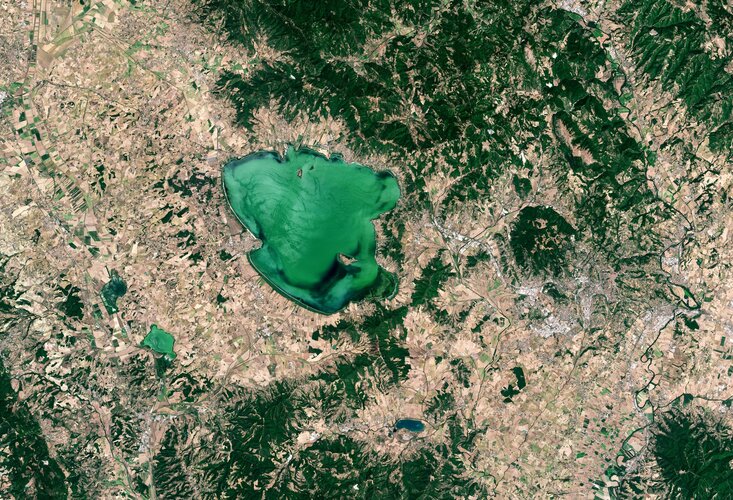
Lake Trasimeno, the fourth largest lake in Italy, is featured in this week’s Earth from Space image.
ESA selects Harmony as tenth Earth Explorer mission
22.9.2022 16:20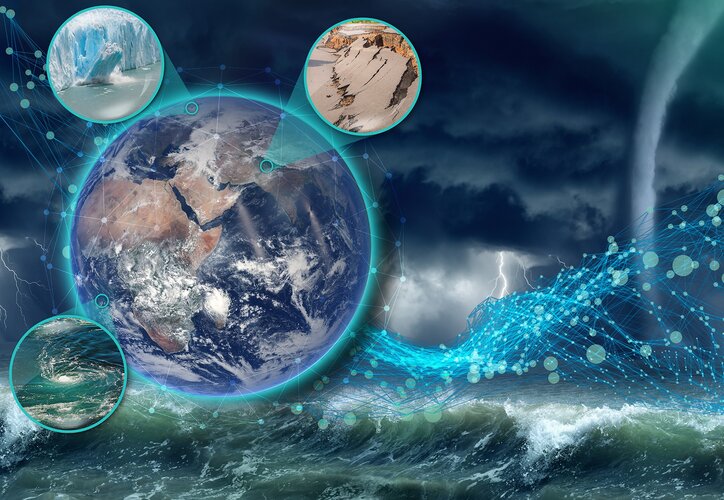
Following preparatory activities and a stringent process ESA Member States today formally selected Harmony for implementation as the tenth Earth Explorer mission within the FutureEO programme . This unique satellite mission concept is, therefore, now set to become a reality to provide a wealth of new information about our oceans, ice, earthquakes and volcanoes – which will make significant contributions to climate research and risk monitoring.
ESA selects Harmony as tenth Earth Explorer mission
22.9.2022 16:20
Following preparatory activities and a stringent process ESA Member States today formally selected Harmony for implementation as the tenth Earth Explorer mission within the FutureEO programme. This unique satellite mission concept is, therefore, now set to become a reality to provide a wealth of new information about our oceans, ice, earthquakes and volcanoes – which will make significant contributions to climate research and risk monitoring.
Mediterranean Sea hit by marine heatwave
22.9.2022 13:20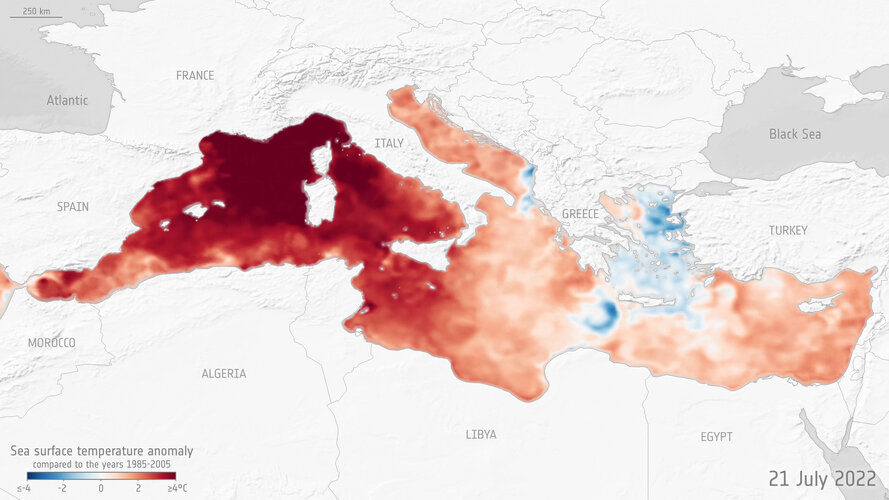
Many parts of Europe saw record-breaking temperatures over the summer, but it wasn’t just the continental mainland that was affected: the Mediterranean Sea also suffered a major marine heatwave. An ESA-funded project, CAREHeat, detected one of the most intense Mediterranean marine heatwaves observed during the satellite era – with sea surface temperatures reaching 5°C higher than average.

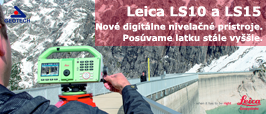








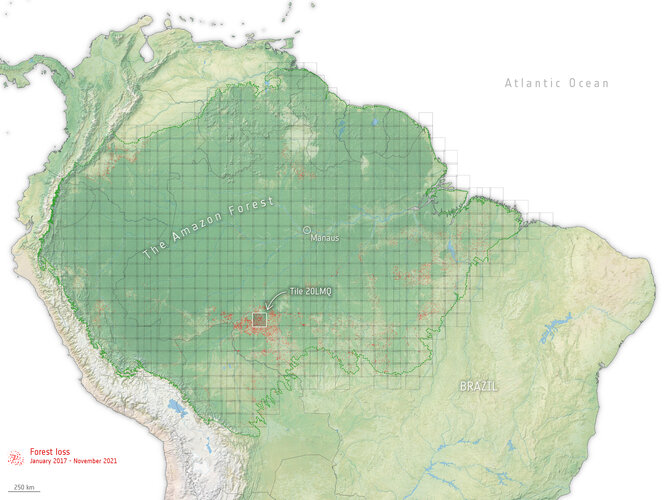
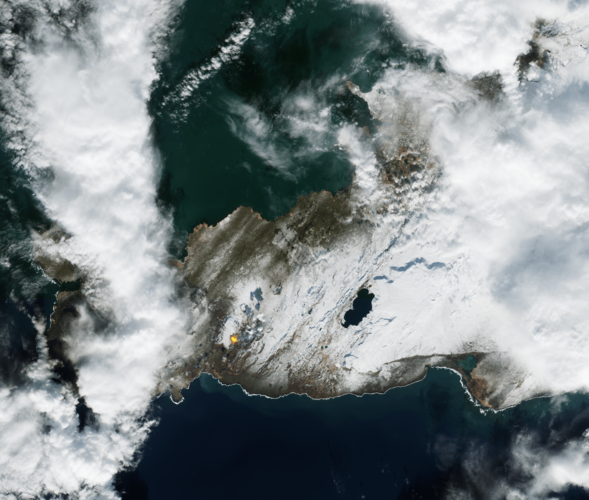

 Image:
ESA Extremes
Image:
ESA Extremes
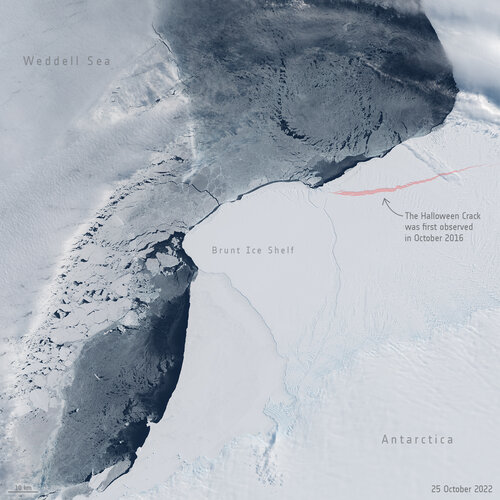 Image:
Halloween Crack for Halloween
Image:
Halloween Crack for Halloween